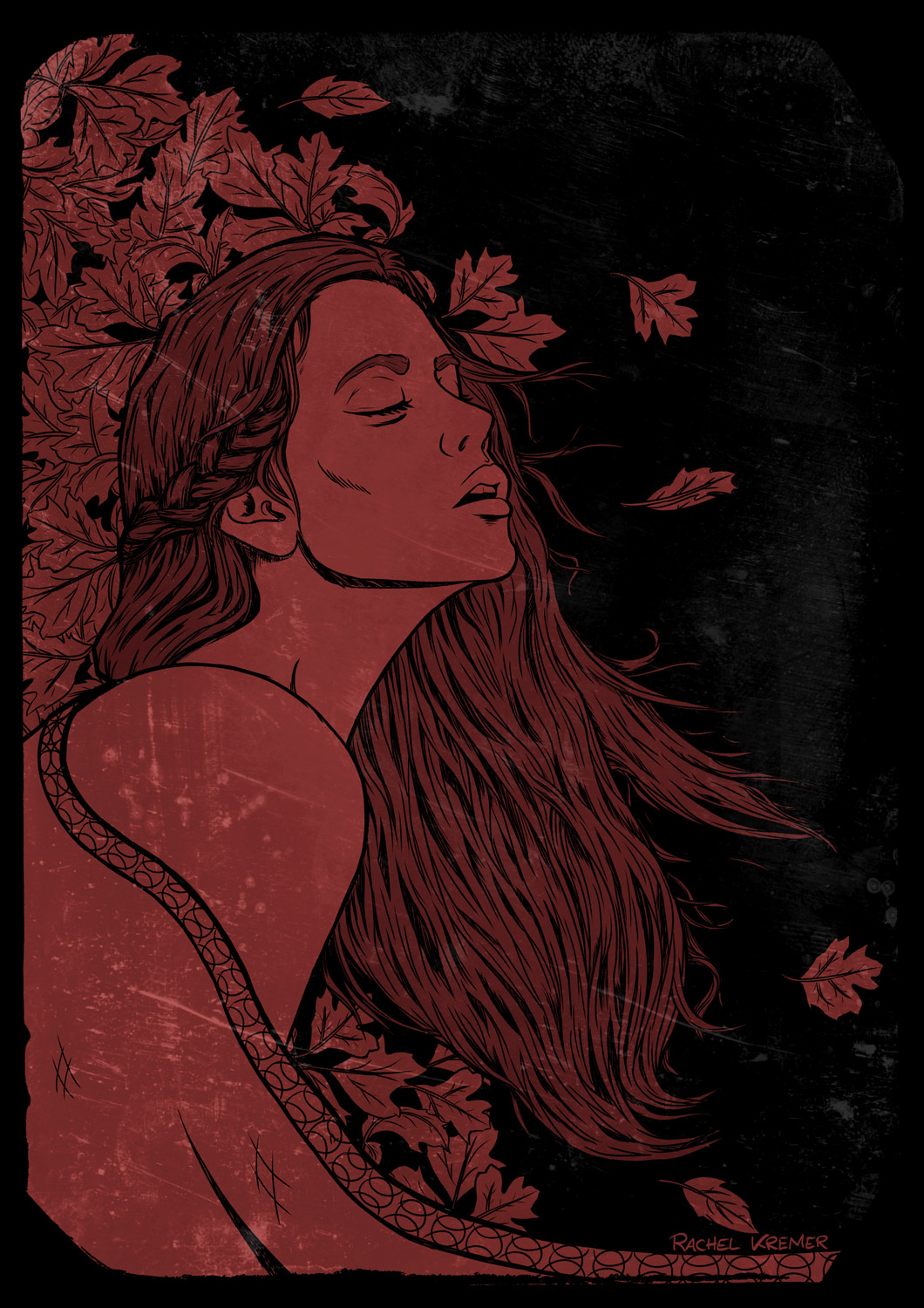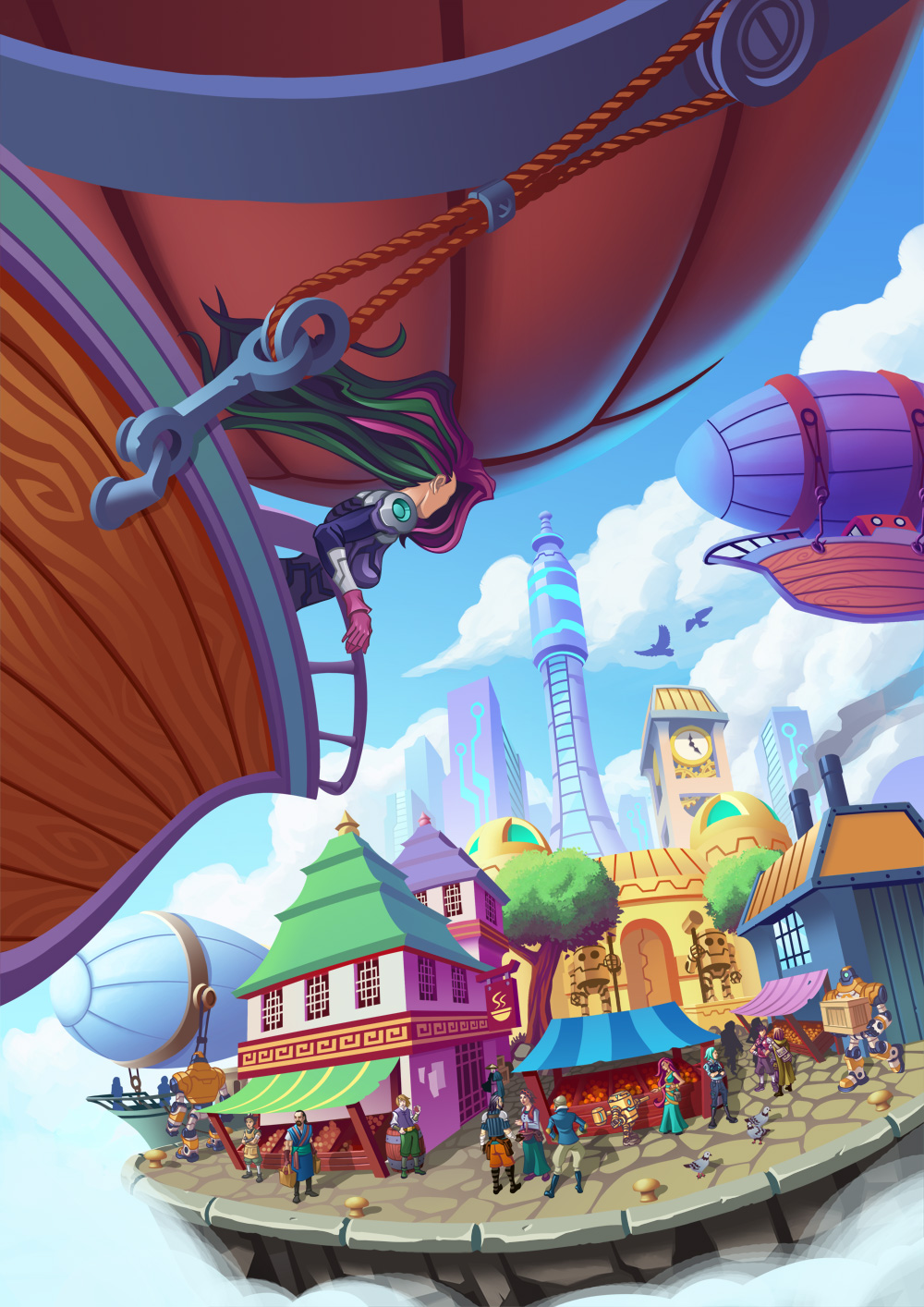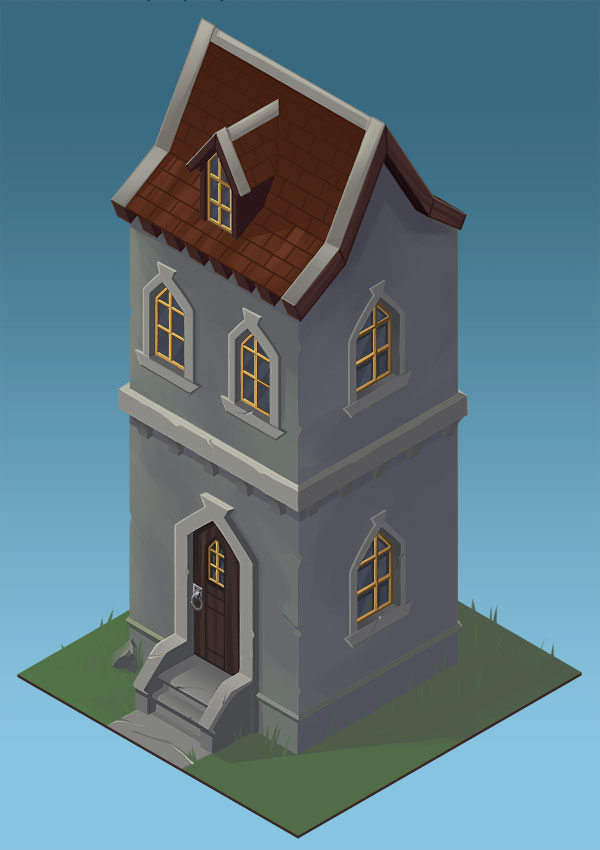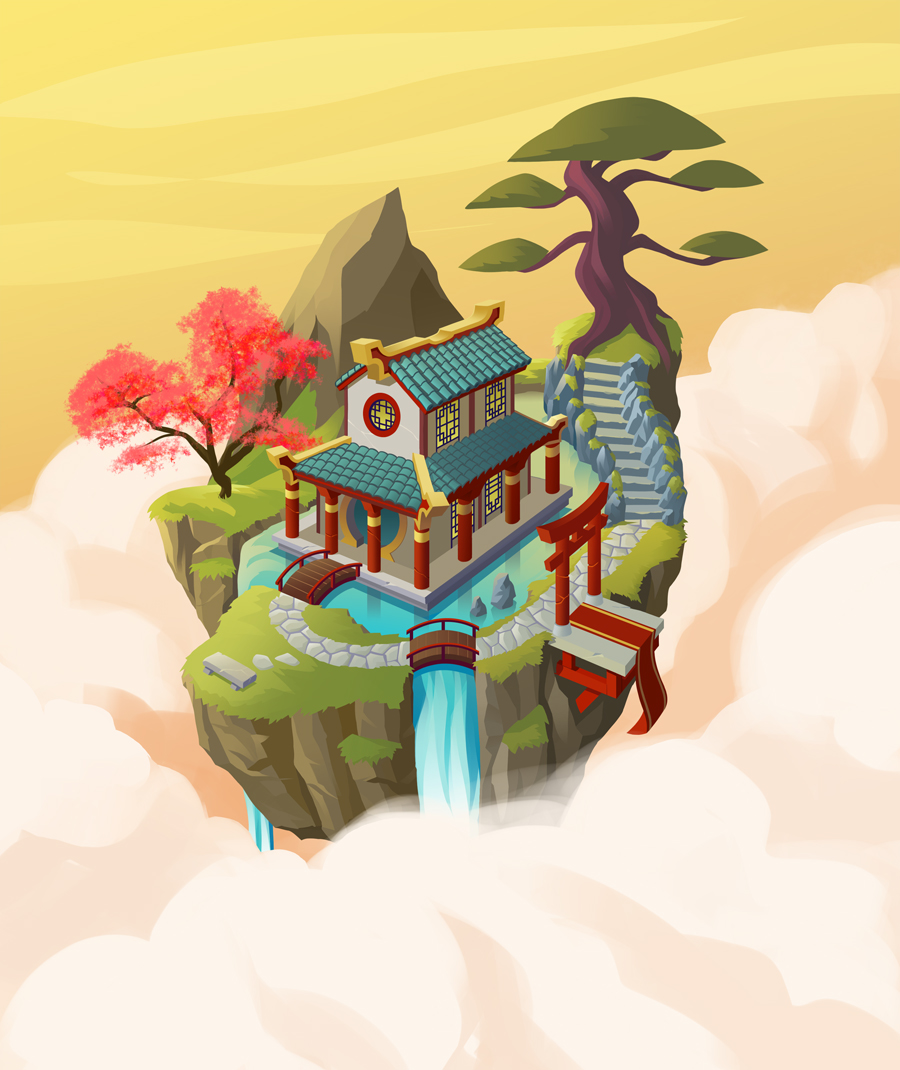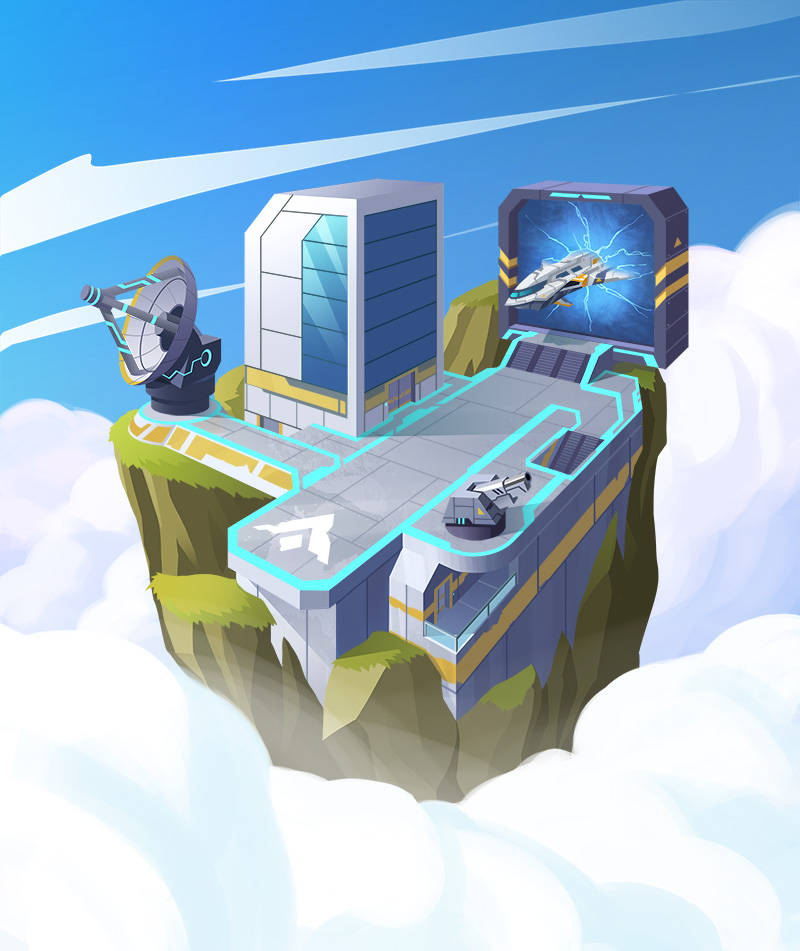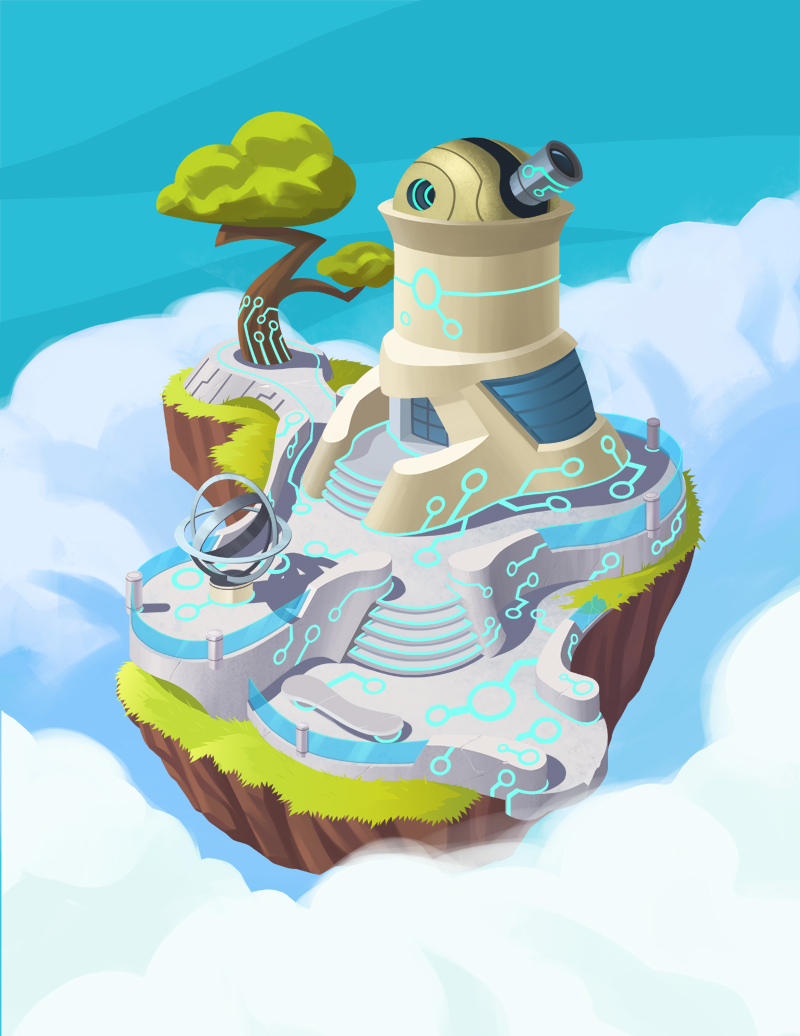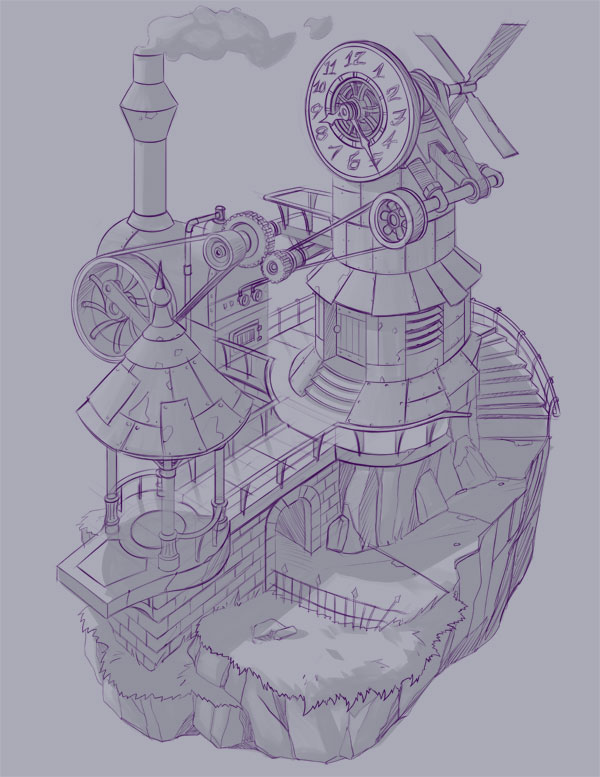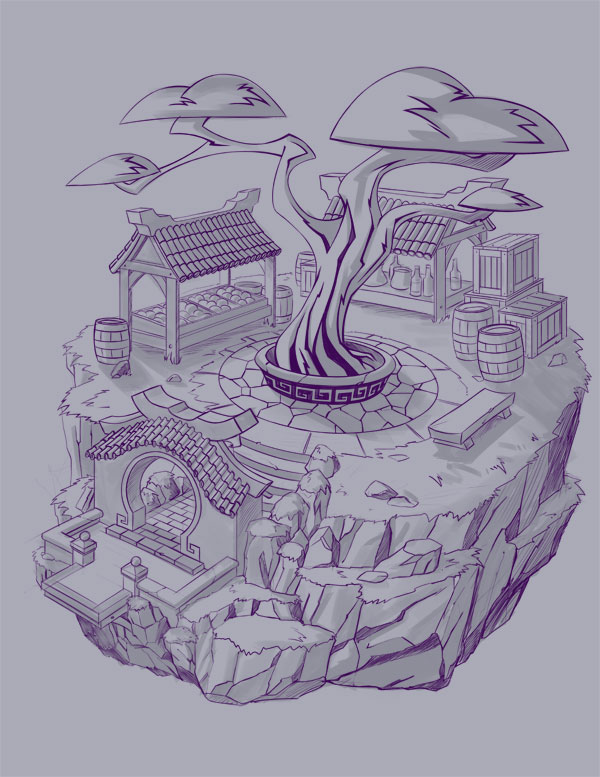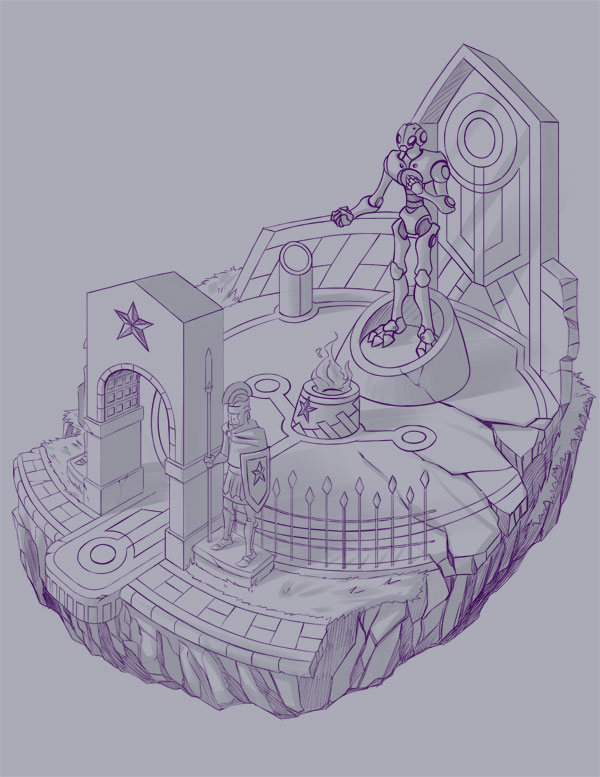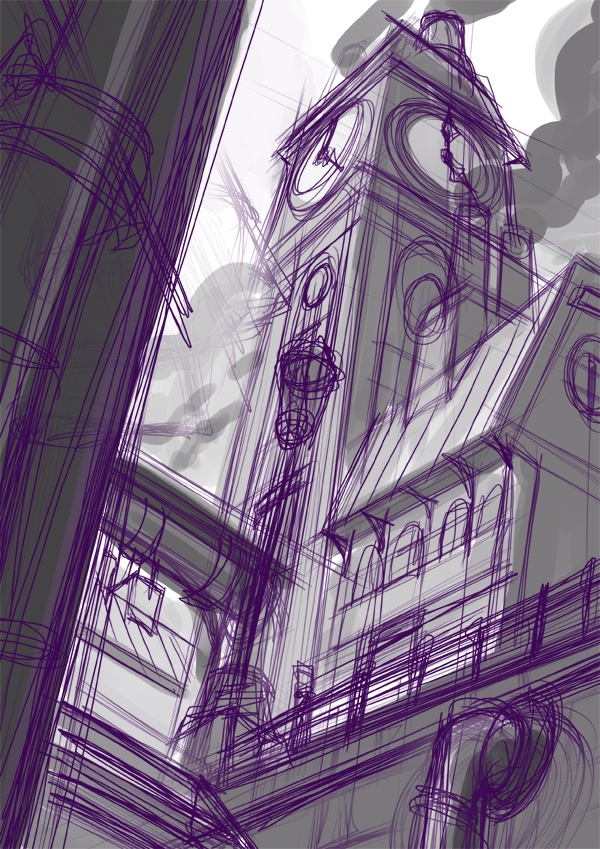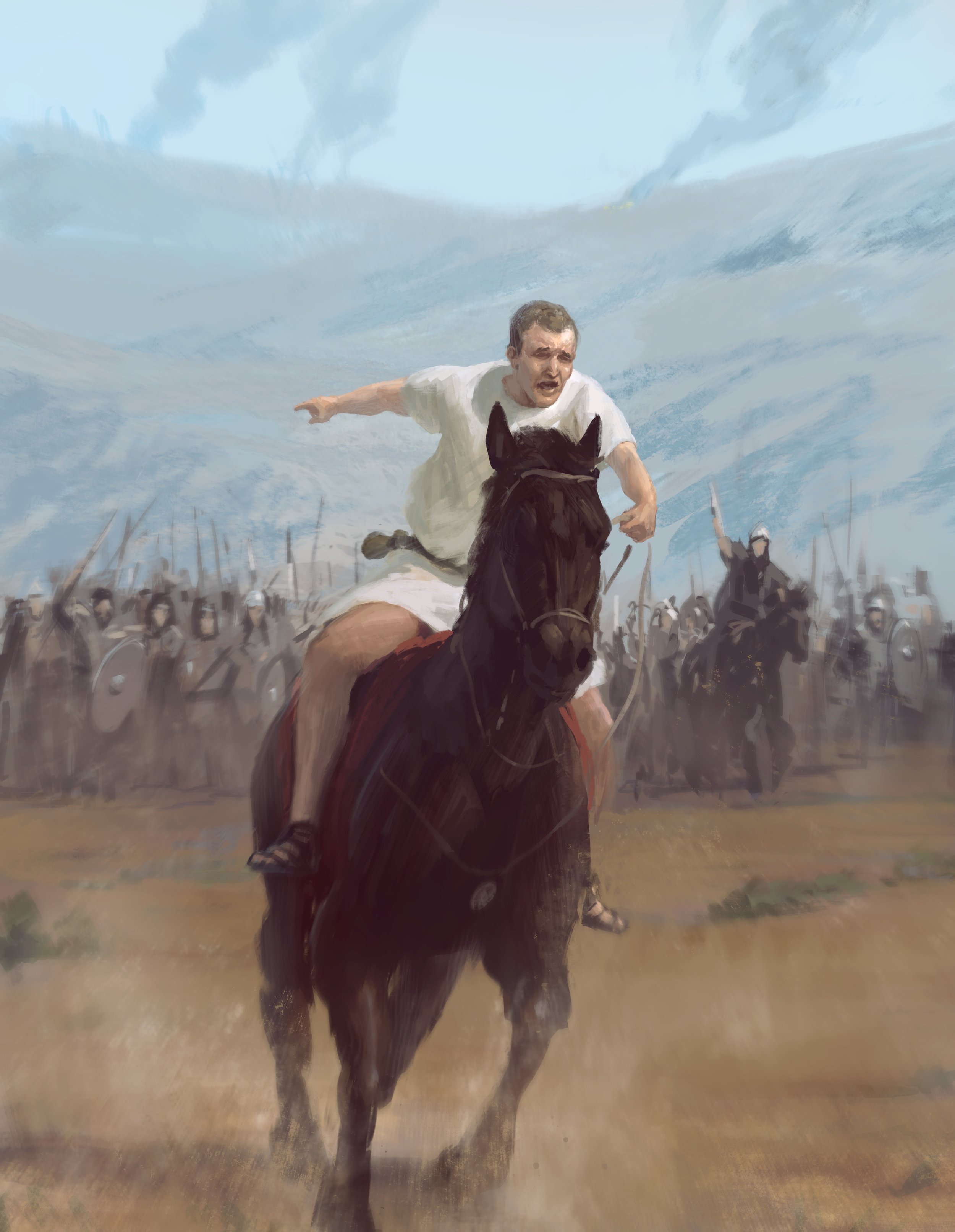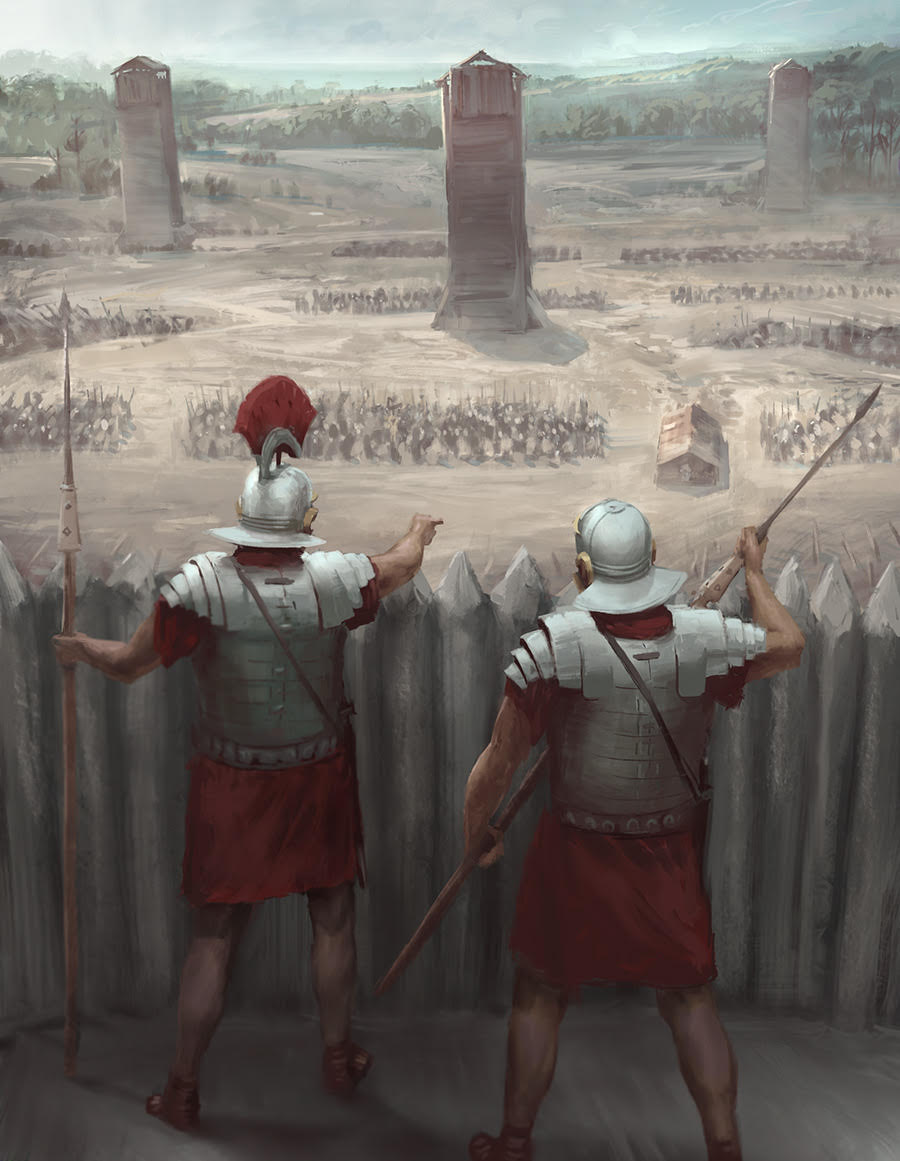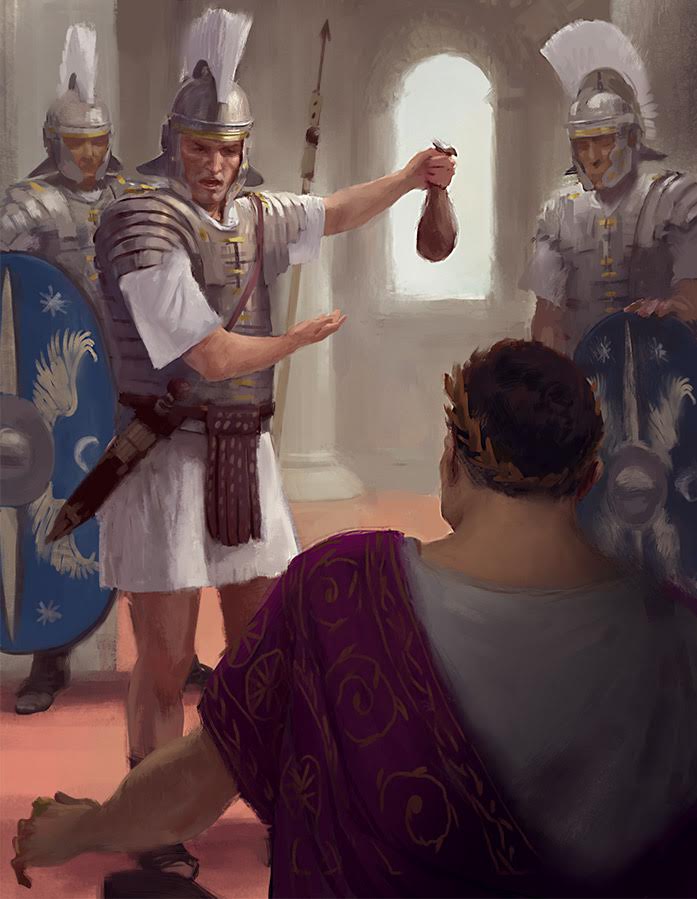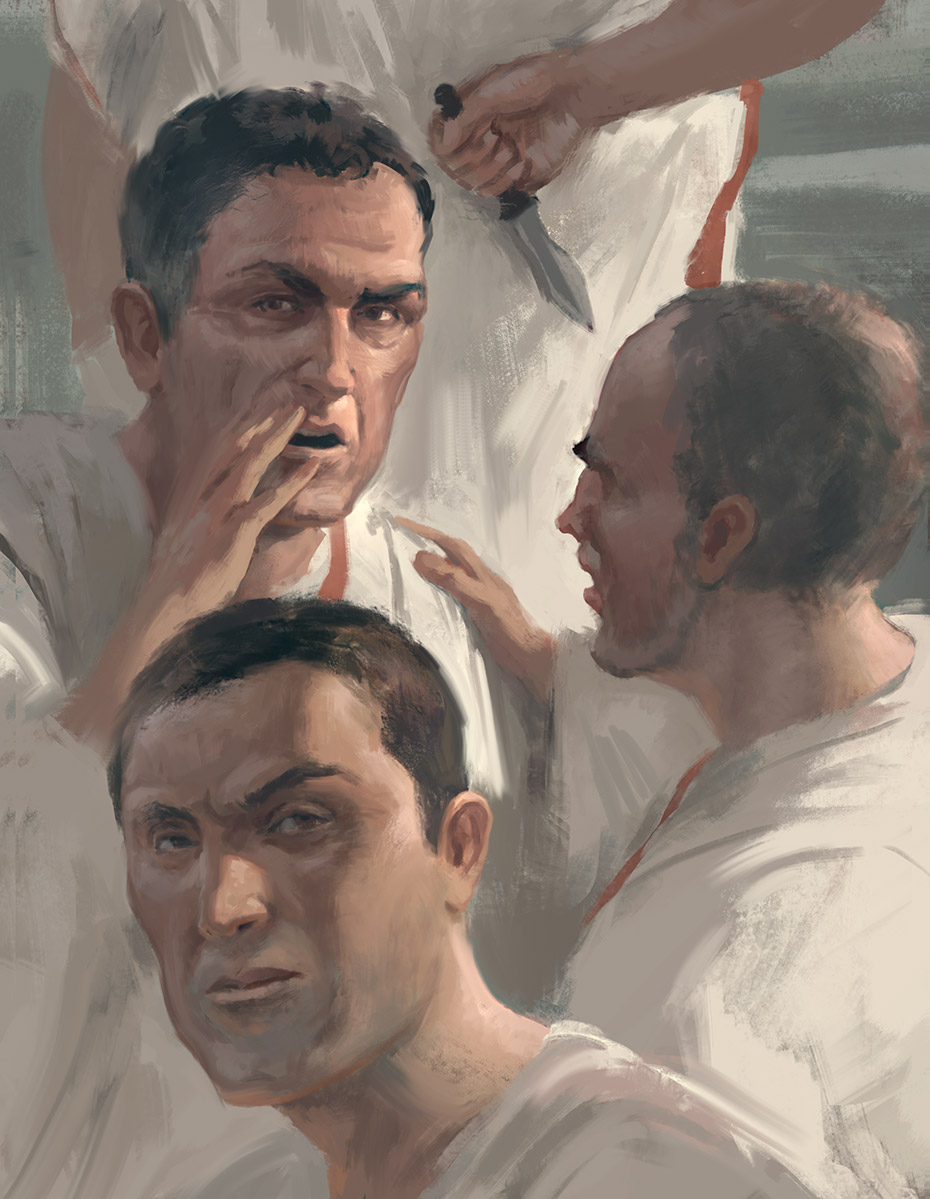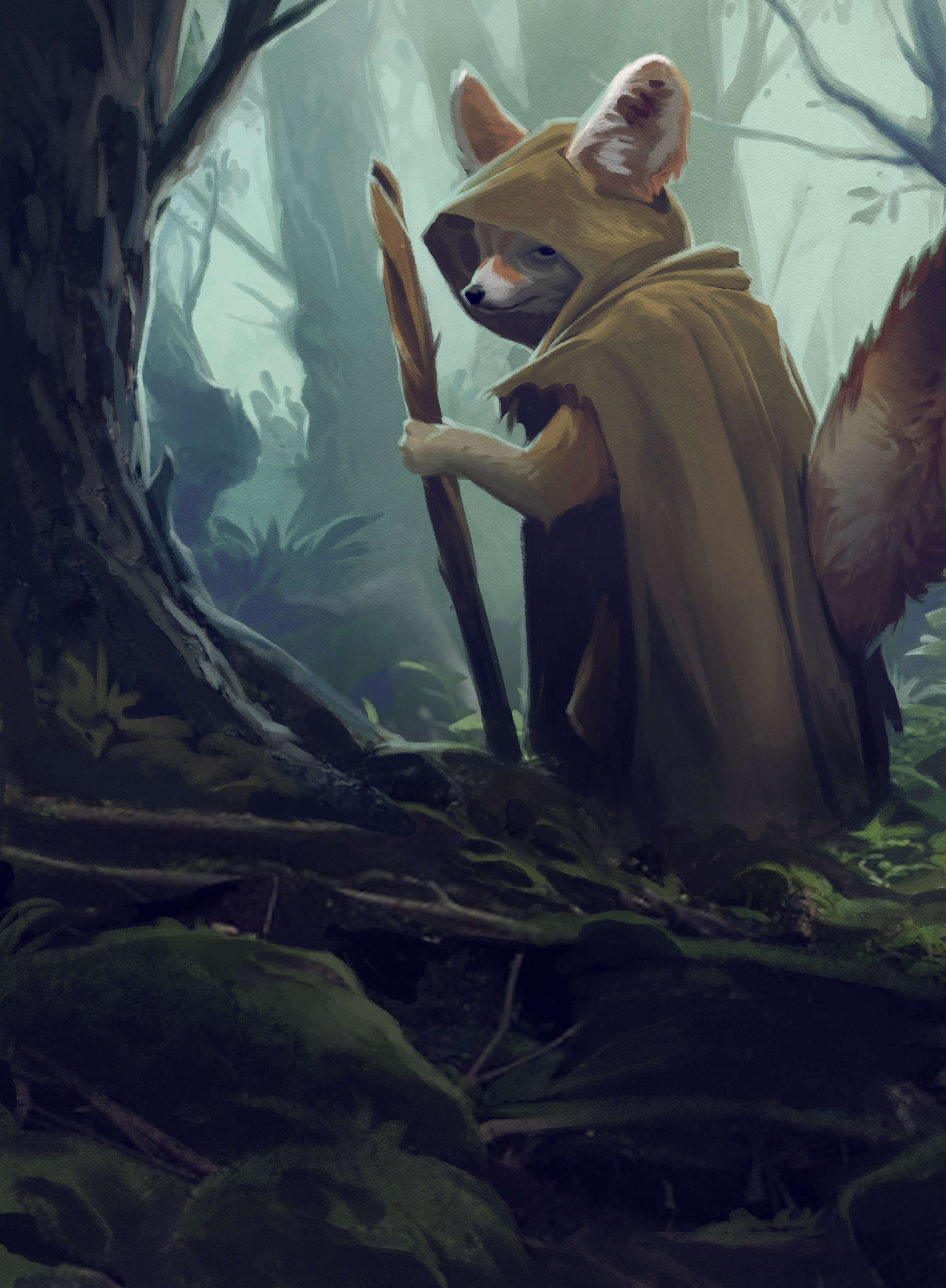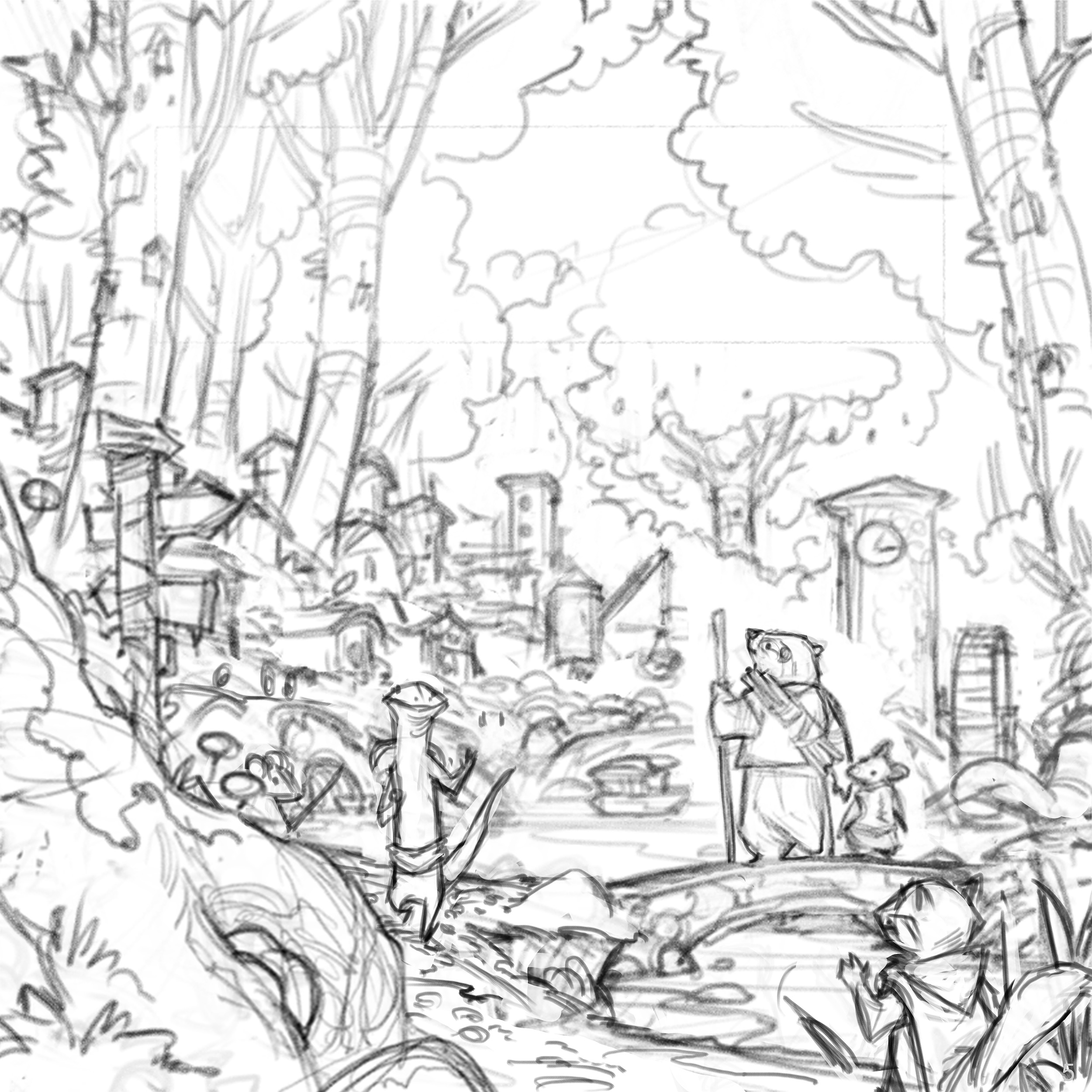Kyle Ferrin: Art in Board Games #31
How a game works isn't always immediately clear, but you can say a lot about what the players will feel like by giving them at-a-glance information through visual communication
Quick editor’s note: I've recently changed the format of how I conduct my interviews. Previously I had always stuck to a predetermined list of questions but I've decided to move away from that fixed format into something more organic. Below are the first fruits of this so I hope you enjoy the results.
Hi Kyle, thanks for joining me! For readers who aren't aware of your work, could you tell us a bit about yourself and what you do?
Yeah! I'm a board game illustrator that works for Leder Games. I illustrated Vast: The Crystal Caverns and I'm currently working on Root and Vast: The Mysterious Manor. I've also done work for Norwester Games on their "Stitches" title, and a few other commission jobs that should be revealed soon! I live, (and work) just north of Salt Lake City, Utah with my wife and 4 kids.
What are the first few things you do when starting a new project?
If I have my choice I like to be heavily involved in the theme of a game. I get a rough idea in my head of what I'd like the game to look like and then it's a matter of making a lot of sketches and collecting references to run by the game designers/publishers. I'm constantly in my sketchbook and in some cases, like with Root, it was a case of building a concept around sketches that I'd already made. I was going through a small animal with swords phase and I had multiple people ask me on Twitter if the characters I was posting were from anything. I guess they are now!
Where do you think your small animals with swords love comes from?
My 5th Grade teacher read Redwall by Brian Jacques to our little class and I think I read a sizable chunk of the series into junior high school. I don't remember a lot of details but I remember the feeling it gave me and that overall vibe has been something I've enjoyed revisiting. Other influences include David Petersen's wonderful Mouse Guard comics and my obsession with Disney's Robin Hood. I can still quote pretty much ALL of Robin Hood, including background music and sound effects. Obviously what we ended doing for Root is still a pretty far departure from those art styles, but those worlds were pivot points when I was doodling little warrior creatures for my kids or for myself.
Your first board game project was VAST. How did you get involved and what do you remember about the project?
Vast was my first big foray into board game illustration. It was originally called "Trove" and the original designer, David Somerville, was looking for goblin art to accompany his work. He found a goblin illustration I did for the RPG Dungeon World, and when David sold the game to Patrick Leder, my name came along as an option. Patrick and I work on the same wavelength and I've been on the Leder Games team ever since. I started out as a contractor, but when Vast saw the success that it did I was hired on full time to work for Patrick.
The thing about board game illustration is that if you are working closely with the game designers then some things that you've worked really hard on get axed. Play-testing reveals that a certain card doesn't work, or the production constraints restrict the number or tokens that can be printed affordably. It's better to have an overarching vision of what you want the game to look like than to be married to any particular aspect.
I was also very fortunate to have people relate to my Vast art. There are SO MANY new board games, and a huge spectrum of art styles. To help us stand out I tried to embrace a line-art heavy style a la Advanced Dungeon & Dragons monster manuals, but with a vibrant color palette. We wanted to keep Vast looking accessible and family-friendly, which meant keeping the goblins looking more mischievous than violent, and making sure the heroine protagonist was fully clothed. I get a lot of comments from the board game community about how appreciative they are about the sensible armor for the Knight.
Vast was when I first started going to game conventions too. That was a whole new world for me. I think if you would have asked me 10 years ago how many people there were in the US that were REALLY into board games I would have estimated less than a thousand, haha. I just had no idea! I've always loved board games but most of my experience was with Risk and Monopoly and whatever was in my grandma's closet. I'll never forget my first Gen Con on that Thursday morning when an older gentleman struggled a little to lift up the Vast box and asked "How much is this?" and I sheepishly answered $60, not wanting to break his heart. He said, "I'll take one" and his son rounded the corner with 2 enormous bags full to bursting with what must have been thousands of dollars of board games. On Thursday Morning. The first few minutes of the convention! I've fully embraced the board game lifestyle since then, and I have a modest little collection of games, mostly for playing with my wife, my siblings and my adult friends since my kids are all pretty little.
How has witnessing playtesting influenced the art you create? Is there anything you're more mindful of now?
It's fun to see people play test a board game while you're still working on the art for it because you get almost immediate feedback on what people are interested in. Especially with Vast, when the rules for each player are so different, players are choosing roles based on theme and aesthetic. Unless you have a pretty good understanding of how Vast: The Crystal Caverns Goblins work going in, you probably aren't going to say "Oh, I'll be the green guys because I like push your luck mechanics." You're a lot more likely to hear something like "Oh! I want to be this Dragon" because of the theme and the art. That's where I think it's important that you're doing the game designer's work justice. How a game works isn't always immediately clear, but you can say a lot about what the players will feel like by giving them at-a-glance information through visual communication.
What I've learned about the game-making process and how I work is that it's pretty crucial that I understand how the game plays on some level before I can illustrate it. I can save myself a lot of time with revisions if I understand the intent of the game designers. The tone is important. Accessibility is important. Card dimensions are important. It's all important.
Were you surprised by the communities reaction to the artwork on Vast?
Yes! I was also really pleased with what I had made with Patrick and David and the gang. It wasn't a case of "Oh wow this thing I did in my spare time is a hit" so much as "Thank goodness people like this so much, I put a bananas amount of effort into this as someone that has a day job and 3 kids" haha. When we sold out of everything we brought to that first Gen Con I was stunned. We had a few really positive reviews that were timed perfectly before the convention and it was pretty surreal to see our pile of games with my drawings on them disappear.
Did your experience creating Vast change your approach when it came to Root?
The biggest difference was time. When I was working on Vast it was at night after my kids went to bed, email back and forth, and then during the day I had to switch gears in a major way because I was working as a graphic designer for a fun run management company. After Leder Games hired me on full time I haven't had to switch gears as much and that's been an enormous boon for my workflow.
I had undiagnosed ADHD up until about the time I graduated high school when my parents and I got a diagnosis. Because of that time spent in school with a problem I didn't know I had, I have a lot of little weird coping mechanisms for trying to stay on-task, and it's gotten a lot better as I've gotten older, but if I can just "zone in," (or maybe it's better described as "zoning out,") I can get a lot more work done. Working full time on illustration has been an incredible blessing and it's what I would wish for anyone who can make it work. My wife, Meredith, works full-time nights, and we get health insurance through the hospital where she works. It's not always a perfect arrangement but it's a big improvement from the creative atmosphere I was in 2 or 3 years ago. It's a team effort and I'd be remiss not to factor in how much what my wife does makes what I do possible. Money is horrible and it would be nice if we could all make fun things and help people we are able to right now. We are very privileged, and we try to pay it forward where we're able.
Okay, ROOT! haha, sorry. Working with Cole Wehrle has been great, and part of the reason is because he cares about theme so much. With Root we wanted to make a war game that wasn't tied to any specific historical context, so because of that we had to make our own world rules. Leder Games has more titles in the works with anthropomorphic animals, and Patrick agreed that setting would be a good fit, so it was just a matter of establishing factions and roles that lend themselves well to the archetypes we wanted to include. I was STOKED to be a part of this process. I got to help establish the woodland creatures that we would include, and the cats being the ruling usurpers, and the raccoon vagabond, etc. It was a new approach to creating the theme for me because I got to be pretty heavily involved in the early shaping. Instead of trying to match a vision I had the opportunity to pitch ideas and sketches and I think that holistic way of making the game's style benefits the overall quality of the end product.
I adore the colors you use in your illustrations. Are your choices purely an aesthetic thing or are you trying to convey a theme or feeling also?
Thank you! I feel like I'm still trying to find my stride with color, it doesn't always come naturally to me. I took color theory courses in college and watercolor painting classes when I was a teenager, and I think those things inform a lot of my decisions when it comes to the values I work with even I'm coloring digitally. I like to see paper texture and I like to use heavy line art and hatching when I use ink, so that means that my values tend to be lighter so I don't lose that detail. I don't want to stick to those methods forever but that's been a go-to for me on a technical level.
As far as conveying a theme I think color is a wonderful way to do that, and that was my intent with the Root art. Most of the color pallet for the board art in Root is sampled from autumn foliage photography. I get inspired by fantasy settings and playing tabletop games in the fall as the weather changes. Those are powerful emotions for me and Root gave me a chance to create an autumn forest for people to relate to. I hope that comes across for other people the way it speaks to me.
I'm the kind of person who gets interested in a game for aesthetics first, so contrast and temperature and color composition are important from a first-glance perspective. Especially at conventions I try to think about table presence. I think it's just as important as being able to read the game state. Would you want to see what the game was? Would you move in closer to check out the details? I think color is the first thing that communicates that. It breaks my heart to see games that look interesting and otherwise well-made that have uninspired color schemes, so I'm trying to avoid that.
I will also say that I'm happy to see more people in the industry making an effort to have their board games be accessible to color-blind players and that balancing of what I want it to look like vs. what makes the best sense for a wider audience isn't always easy but always feels worthwhile.
What are you currently reading, listening to or looking at to fuel your work?
I am *currently* listening to Tame Impala's album "Currents" I can't imagine working at a desk without some kind of music subscription service. I come from two schools of thought about listening to music while drawing. I had some professors who swore by having the radio on constantly for productivity purposes and some professors who didn't want us wearing headphones because they believed it affecting what we were working on too much. I think I kind of believe both? haha. If I'm coloring or just doodling for fun I'll listen to all kinds of music. If I'm inking conceptual art for the first time or trying to nail down a composition I'll get more choosy. The Conan the Barbarian soundtrack is pretty consistent fuel source when I'm focusing on fantasy.
As far as the media I'm into right now, I watch a lot of HGTV and Food Network with Meredith when we have time just hang out together, I don't know if that's informing my drawing hand at all, haha. I can't wait for the weather to get a little warmer so I can spend more time outside with my family. That's my biggest source of inspiration.
Board game-wise I've been pretty into Rising Sun. I think I've played it 6 times already with a few different groups. It's a beautiful game with a surprising amount of depth.
Do you have any current projects underway, or coming up that you’d like (or are able) to tell us about?
Leder Games is just finishing preparations for Root to go production, and my focus is shifting to Vast: The Mysterious Manor. Vast: TMM will be a standalone sequel to The Crystal Caverns that adds even more to the variety if you have both games. You can play as a Paladin, a horde of Skeletons, a giant shape-shifting Spider, a sneaky Enchanter, or even as the haunted Manor itself. Watch for that to come to Kickstarter soon. Leder Games has a bunch of other great stuff in the pipeline that I probably shouldn't talk about yet. ;)
I also illustrated a little solo game for Golden Bell called "Die Trying" that's designed by David Somerville. It's a solo survival mountaineering about trying to climb a lethal mountainside. It sounds dire but it's actually very tongue-in-cheek and I think people will find it very cute. That's coming soon but I'm not sure about the timeline there.
Finally, if we’d like to see more of you and your work, where can we find you?
I'm always on twitter, it's a problem! My handle on Twitter and Instagram is @d20plusmodifier. If you follow me there you'll see works in progress, process stuff, and the occasional political rant. I also post what conventions I'll be attending if anyone wants to say hey in real life or hear me have a political rant in real life. I also have a little shop at kyleferrin.threadless.com if you'd like to check out shirts and whatnot. :)
(All images supplied by Kyle Ferrin, 2018)
Semi Co-op: Art Outside Boardgaming #1
At first I just started designing the characters that were going to be based on Heinze and me. I read ‘Understanding Comics’ and ‘Making Comics’ by Scott McCloud and just started drawing some. Three out of four were jokes about board games, so together with Heinze I decided to throw away the idea of a webcomic about geeky subjects in general and decided it would be better to focus on board games.
Time for a little something different. This week I’m joined today by Rachel Kremer and Heinze Havinga, creators of Semi Co-op, a weekly webcomic (mostly) about board games that’s also just passed it’s 150th comic.
Firstly, congratulations hitting that landmark number, that’s a serious achievement! How does it feel?
Rachel: Slightly unreal! Looking at some older comics it feels like I’ve made them only a few weeks ago, but it turns out it was over 6 months ago. Overall I’m really proud that Semi Co-op has made it so far and even more proud that we never skipped one week.
Heinze: I’ve just drawn one comic when Rachel was kidnapped for her bachelor party, but that took me almost two days. So I’m incredibly impressed Rachel is able to keep it up every week.
So for those not currently in the know, elevator pitch time, what is Semi Co-op?
Rachel: In short, Semi Co-op is a webcomic about board games! It’s about our own experiences with playing board games… only a tiny bit more exaggerated here and there.
Heinze: Also there are some couple jokes, but games are the most important thing.
Can you tell us a bit about yourselves outside of Semi Co-op?
Heinze: I teach subjects like big data and web technology at a university of applied science in the Netherlands, where I am also a researcher on the topic of smart cities. Next to that I’m writing my master thesis right now and will hopefully be done in June. When I’m not working I like redesigning chocolate bars, creating laser cut storage solutions for games and fooling around with synthesizers.
Rachel: I’m a freelance illustrator and animator. I enjoy working in a variety of styles and have a broad skill set. I’ve added some of my work to show in this article to give you an idea of what I do besides Semi Co-op. I’ve drawn storyboards, graphics for digital games, animation, birth and wedding cards and made animations for several companies. Ironically, I’ve never done any art for board games (besides a version Love Letter I designed for our wedding). It’s something that I would love to explore though.
You’ve said that you had no experience in creating comics before this, so where did the idea start and how long was it before you made that first panel?
Rachel: I wanted to improve on drawing cartoon characters, something I had little experience with. I decided I needed a project to really motivate myself and I had been playing with the idea of a webcomic. At first I just started designing the characters that were going to be based on Heinze and me. I read ‘Understanding Comics’ and ‘Making Comics’ by Scott McCloud and just started drawing some. Three out of four were jokes about board games, so together with Heinze I decided to throw away the idea of a webcomic about geeky subjects in general and decided it would be better to focus on board games. We wrote down about two pages of ideas for comics and I drew six of them and showed to them to friends to see if they liked them and asked for feedback. I think I started working on the first comics in January and launched Semi Co-op on April 11th 2015.
How do you usually come up with your ideas? Where does the inspiration come from?
Rachel: Playing games!
Heinze: Also board gaming content on the internet. We are always checking Twitter, Instagram and the board gaming Reddit. We also watch videos and podcasts, although we don’t have enough time to check all the amazing things people are producing on that front today.
What are your favorite panels of the comic so far? Why is that?
Rachel: I love the comics that really go into a game. Like the second panel in ‘Show & Tell’ and the third in ‘Can’t touch this’ (above) or comics that take on the art style of a game like ‘Small World Favorites’. I love that such comics are little more challenging to make and require me to study the art of games. But they are more time consuming to make so it’s not something I can do too often.
Heinze: Dialog-wise: I really like the last panel of our comic about iconography in games (below), art-wise I really like the sneaking Hobbit in front of the dragon.
Is there a board game you’d love to create a comic about but haven’t been able to yet?
Heinze: Biblios, it’s such a good game, but we haven’t found the right joke for it, you can send suggestions to: ihaveabibliosjoke@semicoop.com.
Rachel: I agree with Biblios! And I just noticed we’ve never made a comic about Love Letter, that also seems like something we should definitely consider.
Do you have any goals in mind with the future of Semi Co-op?
Rachel: Certainly! We’re momentarily working on a new website that will be launched this March. We’ve been looking into ways of (partly) monetizing Semi Co-op that we would like to present to the world this year. We’ve got some solid ideas that I’m really excited about but I can’t mention them just yet.
Heinze: I would love to make more animations. The way we do the videos now can be done without Rachel having to draw anything, just doing the voice-over for her parts. But I would need to free up some time to be able to deliver on schedule, plus Rachel would need to expand on our current animation rigs which is a big one-time investment.
Do you have a favorite board game at the moment?
Rachel: Ohh, this is a terribly difficult question and I don’t know if I have only one favorite. I always look forward to playing Pandemic Legacy Season 2, Near and Far, Mysterium and Arkham Horror the Card Game.
Heinze: I really enjoy those games as well, right now we’re really into the story heavy campaign games.
What are you currently watching, reading or listening to at the moment that you’d like to share?
Rachel: I recently started watching Critical Role, I really enjoy listening to it while drawing. We’re currently also watching Star Trek Discovery, Elementary and The Good Place together. I also have a weakness for series like Downton Abbey, Mr. Selfridge and Gilmore Girls (I just really enjoy the dialog!).
Heinze: I listen/watch a ton of what John and Hank Green content like Vlogbrothers and Dear Hank and John, I like their shameless passion for things whether they are silly, like a small English football club, or important, like the decreasing the amount of world suck. They show that being playful and intelligent cannot only work but be entertaining as well. I’m also really impressed with the work of Nicky Case, who is trying to educate people about topic ranging from society to his own feelings using games, infographics, playable blogpost and all manner of super interesting hybrid media forms. I always wanted to see storytellers that choose/create the medium that fits their story best and I think he is doing remarkable things. Also his Newgrounds inspired flash art style is almost nostalgic to me.
Finally, what’s coming up for Semi Co-op this year that you are willing to share with us?
Heinze: We are going to UKGE, which is going to be great, because we’ll meet a ton of people we’ve been talking to online for years.
Rachel: Also look out for our three-year anniversary on April 11th, where we will have some exciting things that will help us reach more people and have more fun with the community!
To see more then go can check out the webcomic on the Semi Co-op website!
Steven Preston: Art in Board Games #30
When I first started on Skyward I made an inspiration folder on my hard drive and kept filling it up with artwork I found [..] As I'd never really drawn any isometric art before, I didn’t know how long it would take or what style to do it in [..] I started looking at more pieces still in an isometric style but with a lot more detail, like something out of an RPG.
This week I'm joined by Steven Preston an artist and art director who recently worked on Skyward: The Airborne City (which was voted into the Top 10 Best Board Game Art of 2017) with Rule and Make.
Hello Steven, thanks for taking the time to speak to us. Firstly, could you tell us a little bit about yourself?
Sure! Well, I currently live in Brisbane Australia and I love comic books, watching Japanese animation like One Piece and I also tend to waste a lot of time playing video games when I should be working on other things. I’ve studied a lot and have a diploma in graphic design and a bachelor’s degree in interactive and visual design.
Now we know a little more about you, I have to ask, as a child what did you want to be when you grew up?
When I was young I was always drawing a lot. Art was one of my favourite subjects in school, but as I got older I wondered if there was a career to be found in being an artist. So I tried some different things; like labourer, kitchen hand and other jobs which I was never really happy with. It wasn’t until I discovered comics that I realised there was a job you could have as an artist, which brought me back to wanting to be one again. I started working on becoming a comic artist, which eventually led to me studying graphic design and being an illustrator.
So how did you first get involved in making board games?
The very first board game I worked on was Robots & Rockets from Rule & Make. I got involved in that by chance really. I’m friends with the game's designer Sye Robertson and I remember they were posting a lot of work in progress (designs of the game) on their Facebook page. Sye was doing all the art and design for the game at the time, so I wasn’t involved at this stage and I remember there wasn’t even a budget at the time for the art, which is why he was doing everything himself. He approached me about creating some art for the game and originally just wanted a single robot done, but as he was happy with what I did it lead to me creating all the artwork.
An interesting part of the design was the need for a variety of head shapes in the robots so they were easily recognisable. Each one shown is busy at a different task, so they’re not all doing the same action. You can also see how the back robot changed from my initial sketch to the final drawing. I made the perspective a lot more prominent in the final just by changing the head angle. One thing Sye wanted with the cards was for the robots not be gendered. So for the card above originally, I was going to do a hat similar to a female air hostess, but that was later removed in the final illustration. The development of that game between myself and Sye was really great and it changed the way the game was originally going to be published. I think it was a real case of being in the right place at the right time.
When you are working on the art of a board game can you give us a quick overview of your creative or thought process and has this changed at all since you first started?
When I first started on Robots & Rockets there was no set template for the design of the cards. I had to design something that was really flexible and what I came up with was the idea of torso type shots and characters with no backgrounds. Another trick was to have a circle in the background and use the circle as a guide for keeping the art centralized.
Now I try and have the template design for the cards done fairly early in the art process, if possible, so I have an idea how much of the art will be covered up by the design. Of course, this template design can evolve as more art is produced and you can see if the design works on multiple cards with different art. As far as my thought process goes with the art itself, I tend to get my ideas fairly quickly just from the name of the cards and what the cards do. I then whip up a bunch of sketches and see if I’m on the right track with what I have in my mind.
You were involved in the creation of Skyward, so could you tell us a little bit about what that involved and what were the biggest challenges you faced?
My original role on the project was to create all the illustration work for the game, but as the game progressed it became evident that if we were going to make the deadline of having all the artwork completed before Kickstarter launch I would need help. This deadline was a big challenge for me since the art style we'd originally planned for Skyward was fairly time intensive. It would have been a struggle to do all the artwork myself as originally planned so the decision was made to bring in more artists to lighten my load and to change the art direction of the project which would also speed up the process.
The Skyward cover art was developed from concept to finished piece as a collaborative process. The original sketch and base lines – Steven Preston. Characters – Ellie Jang. Colours – Neil Martin. Final touches – Steven Preston.
My role in the project also changed to Art Director, so I was overseeing the art as well as paint overs and making changes. Even though I felt kind of bad at no longer being the sole artist on the project, I really enjoyed working with other artists, making suggestions which improved the art and hopefully helped them grow as artists as well. I know for myself that Skyward would look very different today if I was the only artist on it.
What was the inspiration or core idea that drove your work on Skyward?
When I first started on Skyward I made an inspiration folder on my hard drive and kept filling it up with artwork I found which I thought was cool to use. Originally it was mostly isometric art from video games, since that was the style it was going to be. As I'd never really drawn any isometric art before, I didn’t know how long it would take or what style to do it in. I did some test pieces in different styles to see what worked.
These didn’t really work, so I started looking at more pieces still in an isometric style but with a lot more detail, like something out of an RPG. It wasn’t until I saw a piece by Alex Shatohin that I found the inspiration for the art style of Skyward. I could imagine this small fortress separated from the ground, floating in the sky and people being part of this world which gave it that RPG element that I liked.
I would have loved to have done all of the Skyward cards like this, but we found that it was just taking too long and had to find a different style that was faster to complete. I was then inspired by a piece of art by Sergi Brosa which was closer in perspective while still having that feeling of being in the clouds. The use of depth of field in the piece was also something that we used in a lot of Skyward art as well.
Clock Tower art from Skyward was my first piece for Skyward which ended up in the final version, so this became the template for the style of art used for the rest of the game. You can see the use of depth of field with the buildings in the background.
Once we settled on the art style for the game the next challenge was coming up with the graphic design elements of the card. Originally the plan was to have a ribbon type graphic on them which had some texture to it which I had created. But an issue we found was it was hard to work some of the game elements into that design, for example, the launch costs of the cards. It was also taking up a lot of room which took away a lot of the art. It wasn’t really until most of the card art was finished that Allen Chang came up with the design we have for the cards now, which is more modern with some interesting elements like a vertical strip that changes colours depending on the card faction.
What are you currently reading, listening to or looking at to fuel your work?
I can’t work without music so I’m listening to a lot of EDM when I’m working. Like I said in my intro, I play a lot of video games, so I’m always looking at game art for inspiration especially people like Blizzard. I don’t read much in terms of novels, but I do love reading a lot of webcomics. I especially love reading Stand Still, Stay Silent and Awaken.
What advice would you give to anyone wanting to work in the board game industry?
This is a hard question for me to answer because I kind of fell into working in the game industry from my networking really. But I will say that when Allen Chang from Rule & Make was looking for artists to help me out on Skyward he had a few contacts from people he’s met at conventions. So I say networking at conventions is important. Also using places like Artstation or Deviantart is good since I was also using those sites to look for local artists to help out.
Skyward character designs by Steven Preson. These characters were later redrawn for the game by artist Dmitriy Logunkov.
Do you have any current projects underway, or coming up that you’d like (or are able) to tell us about?
At the moment I’m not involved in any projects, but I’ve been talking with Rule & Make about something which I can’t say at the moment.
Finally, if we’d like to see more of you and your work, where can we find you?
Sure, if you want to see more of my work my main portfolio site is http://designinfusion.com/ but I also have a DeviantArt page which tends to have a lot more work on there, such as sketches.
(All images supplied by Steven Preston, 2018)
Donning the Purple: The Art in Kickstarter #1
I wanted an old and detailed styled map. So I contacted Daniel Hasenbos who is a cartographer [..] and by intense research [..] added historically correct buildings and monuments throughout the Roman empire.
Joeri Lefevre provides the all the card art and the amazing box art. I wanted his art pieces to be classical and to depict different situations in the daily life of Roman people [..]
Welcome to a new feature focusing on Kickstarter games. As I often talk to game designers and artists involved in Kickstarter projects it seemed only right that I give this some more attention on my site.
For this first article I'm happy to be joined by Petter Schanke Olsen, of Tompet Games.
Hello Petter, and thanks for taking the time to speak to us. Firstly, could you tell us a little bit about yourself?
I live in Norway and I’m a movie producer by day and a board game designer by night. I launched my first game on Kickstarter in 2016 and that was a light war game called ‘Kill the King’. Now, I'm Kickstarting my second game which is called ‘Donning the Purple’.
I also run a blog where I interview other board game creators about the different tactics they use on Kickstarter.
I have played board games all my life but kind of rediscovered them again when I played games like Dominion and Agricola 3 or so years ago. Now I tend to play medium to heavy strategy games. The longer the better!
So, can you describe your Kickstarter game to us and what makes it interesting?
Donning the Purple is an asymmetrical king of the hill game with a bit of worker placement. Each player leads a powerful family in ancient Rome, trying to get the most victory points during 4 rounds. If your family member becomes the emperor and manages to hold the position he can earn lots of points. However, he will also become the target of the other players, as they will try to dethrone him and become the new emperor themselves.
How long have you been working on this game? What made you launch the campaign now?
I have worked on the game for 1.5 years. It is now finally complete and we have come to a place where we want to be in regards to the marketing so this seems to be a good time to launch. February is also a good month to launch in general.
Why Kickstarter?
We have paid for the art and prototypes ourselves but we need your help to get the funds to print the game. We chose Kickstarter as our crowdfunding platform because that is where the board gamers are.
What was the inspiration or core idea that drove your work on the art?
I have two different art styles in the game:
For the game board, I wanted an old and detailed styled map. So I contacted Daniel Hasenbos who is a cartographer and we worked out a style for the map and it has now become the main attraction of Donning the Purple. Daniel carefully illustrated every palm tree, monument, and coastline. He has a great eye for detail and by intense research has added historically correct buildings and monuments throughout the Roman empire.
Joeri Lefevre provides the other art style in the game. He has made all the card art and the amazing box art. I wanted his art pieces to be classical and to depict different situations in the daily life of Roman people and I think he has done an awesome job. I gave Joeri this sketch when I was telling him how I wanted the box art to look and this is what he turned it into.
Could you tell us about the biggest challenges you’ve faced in creating the art for this game and how you’ve overcome them?
I'm going to let my artists answer this:
Daniel Hasenbos:
"My job was to design the map for Donning the Purple. The map needed to show the Roman Empire at its height, covering most of Europe and the lands around the Mediterranean.
With this came the first challenge. The map needed to give an impression of the geography of the land, but at the same time, it shouldn't distract the players from the game itself. I decided to go for a muted color palette, as not to take attention away from all the other elements of the map, and of course the game.
The map also needed to capture the feel of the Roman Era, while keeping all elements of the map clear, and visible. Throughout the map, I made sure to hide famous features and structures of that time. In addition to that, each capital city is drawn in a style that identifies that area's architecture. This was a great way to show different architectural influences around the Roman Empire.
The result is an elegant map of the Roman Empire, with many hidden details for players to explore. These details, together with the overall feel of the map help people immerse themselves in Donning the Purple!"
Joeri Lefevre:
"One of the interesting aspects of the project is that it’s based in history. How did the people dress at that time? What did the environment look like? I tried to find the answer to these questions in archaeological finds, other artists interpretations of that time, and photos of real-life re-enactors. That’s the formal stuff, but the real challenge is balancing this historical background, with the requirements of the board game and my own artistic interest.
A goal of the image is the story it needs to tell when playing the game. How do I show the player who they are and who the enemy is? Poses, expressions and the colors of garments help to tell the story. To create this, I looked at good reference photos or when needed, shot my own.
Artistically, I aimed to give the box art a hint of a neoclassical painting. With this aesthetic, I hope to introduce the viewer to the historical setting of the game. In the cards, I take a more direct perspective if the concept allows it. To do everything in a manageable timeframe I chose an impressionistic loose way of painting. In the end, it’s an interesting mix of challenges that come together in the images I make."
Do you have any stretch goals involving the artwork? If so how will you manage them?
Yes if we are so lucky and reach some of our stretch goals there will be more art! But I can't say more than that at the moment
What advice would you give to anyone looking to launch a Kickstarter game?
Make sure you bring a crowd with you to Kickstarter. Do not rely on Kickstarter providing the backers you need and also read these blogs! Kickstarterlessons.com & Jamesmathe.com
Finally, if we’d like to see more of you and your work, where can we find you?
You can check out the Kickstarter for Donning the Purple over here and the links for Joeri (www.joerilefevre.com) and Daniel (www.danielsmaps.com)
(All images supplied by Tompet Games, 2018)
Jacqui Davis: Art in Board Games #29
When I started out I tried to do everything for fear of upsetting people, and I still catch myself falling into that mindset every now and then. But I think it’s better to be upfront with clients at the start about deadlines, or whatever the issue may be, rather than dropping nasty surprises on them later..
This week we have Jacqui Davis an artist who has worked with on games such as Ex Libris, Euphoria, Manhattan, Purrlock Holmes and Skyway Robbery and with companies such as Stonemaier Games, Dice Hate Me Games, IDW Games, and Game Salute
Hello Jacqui, thanks for taking the time to speak to us. Firstly, could you tell us a little bit about yourself?
Hi! I’m a board game artist and kid’s book illustrator currently living in Lytham St Annes, a little town in north-west England. I really love it because one of my favourite things to do besides drawing is to go on walks and when the weather allows, this is England after all, there’s plenty of places to go to unwind.
Now we know a little more about you, I have to ask, as a child what did you want to be when you grew up?
It might sound cliché but I always wanted to be an artist ever since I realised that could be a way to make a living. There was a brief period where I considered becoming a scientist so I could invent either a morphing cube (thanks Animoprhs) or a stargate, but that didn’t pan out.
So how did you first get involved in making board games?
Originally I had studied to be an animator but I discovered you need a certain sense of timing that I don’t possess. I also can’t dance, much to my ballet dancer mother’s disappointment!
I got involved in board games after I graduated university. During my studies I followed a few artists who worked in board games, and a good friend Katy Grierson already worked in the industry so I learned a lot from her. The first two clients I had that really got me into the industry where Jamey Stegmaier of Stonemaier Games and Dann May at Game Salute, I really owe them a lot of thanks.
When you are working on the art of a board game can you give us a quick overview of your creative or thought process and has this changed at all since you first started?
I work almost entirely digitally in Photoshop on my trusty Cintiq. Typically my process goes; sketch – colour rough – final, with changes done in-between as I get feedback from my clients. I find the sketching stage the hardest because often if a brief is really exciting I’ll have a finished image in my head and I just want to skip to that and ignore all the boring bits.
Sometimes we nail a design on the first round of sketching, but on others, things get changed along the way. If the brief asks for something specific I’ll always do research while I sketch and I often end up with files filed of references after a project.
You were involved in the creation of upcoming game Neverland Rescue, so could you tell us a little bit about what that involved and what were the biggest challenges you faced?
I think the biggest challenge I had with this game was that we didn’t want to reference Disney’s version of Neverland. You’d think this would be easy, but for me at least that’s where I go when I think of Peter (Pan) so to break that mental image was a bit tough. It was hard not to do a foppish Hook or an impish Peter.
Though the temptation was there I didn't watch or look at images of the Disney versions of the characters. Some things still snuck in, Peter's a redhead, though we tried black hair and decided it didn't work. I went back and looked at the original book illustrations and stills from several stage productions to get ideas since Peter Pan has been a stage tradition for years.
What was the inspiration or core idea that drove your work on Neverland Rescue?
In the case of Neverland Rescue, this one’s pretty easy; we wanted to stick close to J.M Barrie’s version of Peter. Dan Letiman was really great with providing descriptions and images from his copy of the book before I started sketching. He and the team also caught me out when I was leaning too close to Disney and away from Barrie. We got rid of Michael Darling's (Wendy's brother) top hat since that was a Disney invention.
There were a couple of things other things about Barrie's version I didn't know about prior to the game. First of all is the existence of Gentleman Starkey, a member of Hook's crew who has impeccable manners and is 'dainty in his way of killing' (and my new favourite character). The second was that apparently, Tink is 'embonpoint', something I had to look up, which means plump. Also, that mauve faires are boys, white are girls, and 'blue are sillies who don't know what they are'; Tink seemed to me to be a silly.
What are you currently reading, listening to or looking at to fuel your work?
What I listen to doesn’t always come through in my work. I enjoy having Netflix or an audiobook on in the background because it tends to keep me in my seat more than music. Currently, I’m working my way through Hell on Wheels, listening to the Silk Roads: A New History of the World and reading the King’s Curse. Anything about history has my interest and often this finds it’s way more inter my personal art than my professional work.
What advice would you give to anyone wanting to work in the board game industry?
I think my advice would be to make good contacts and be honest about what you can and can’t do. When I started out I tried to do everything for fear of upsetting people, and I still catch myself falling into that mindset every now and then. But I think it’s better to be upfront with clients at the start about deadlines, or whatever the issue may be, rather than dropping nasty surprises on them later in the day.
Do you have any current projects underway, or coming up that you’d like (or are able) to tell us about?
Well, I’m currently working on Neverland Rescue with Letiman Games that I’ve spoken about above that I’m pretty excited about. I’ve also recently done a game with FoxMind Games that will be previewing at Nuremberg Toy Fair that I think will be a lot of fun for kids and adults. It also involves pirates, the last month or so has been pretty fun with all the swashbuckling going on in the office.
Finally, if we’d like to see more of you and your work, where can we find you?
I tend to be most active on Twitter and Instagram, my handle is @logicfairy.
My portfolio is over at jacquidavis.com.
(All images provided by Jacqui Davis, 2018).
Alex Crispin: Art in Board Games #28
Here's a special audio version of the Art in Board Games Interviews. This week I'm interviewing Alex Crispin the illustrator of brand new game Escape the Dark Castle by Themeborne. As we both live in Nottingham it seemed only right we meet up in person to have a face to face chat.
This week I'm interviewing Alex Crispin the illustrator of brand new game Escape the Dark Castle by Themeborne. As we both live in Nottingham it seemed only right we meet up in person to have a face to face chat.
Below is that conversation in audio format. I hope you enjoy, this style of interview is possibly a one-off so if you enjoy it let me know.
Also included is a gallery of game images so feel free to look through these whilst listening.


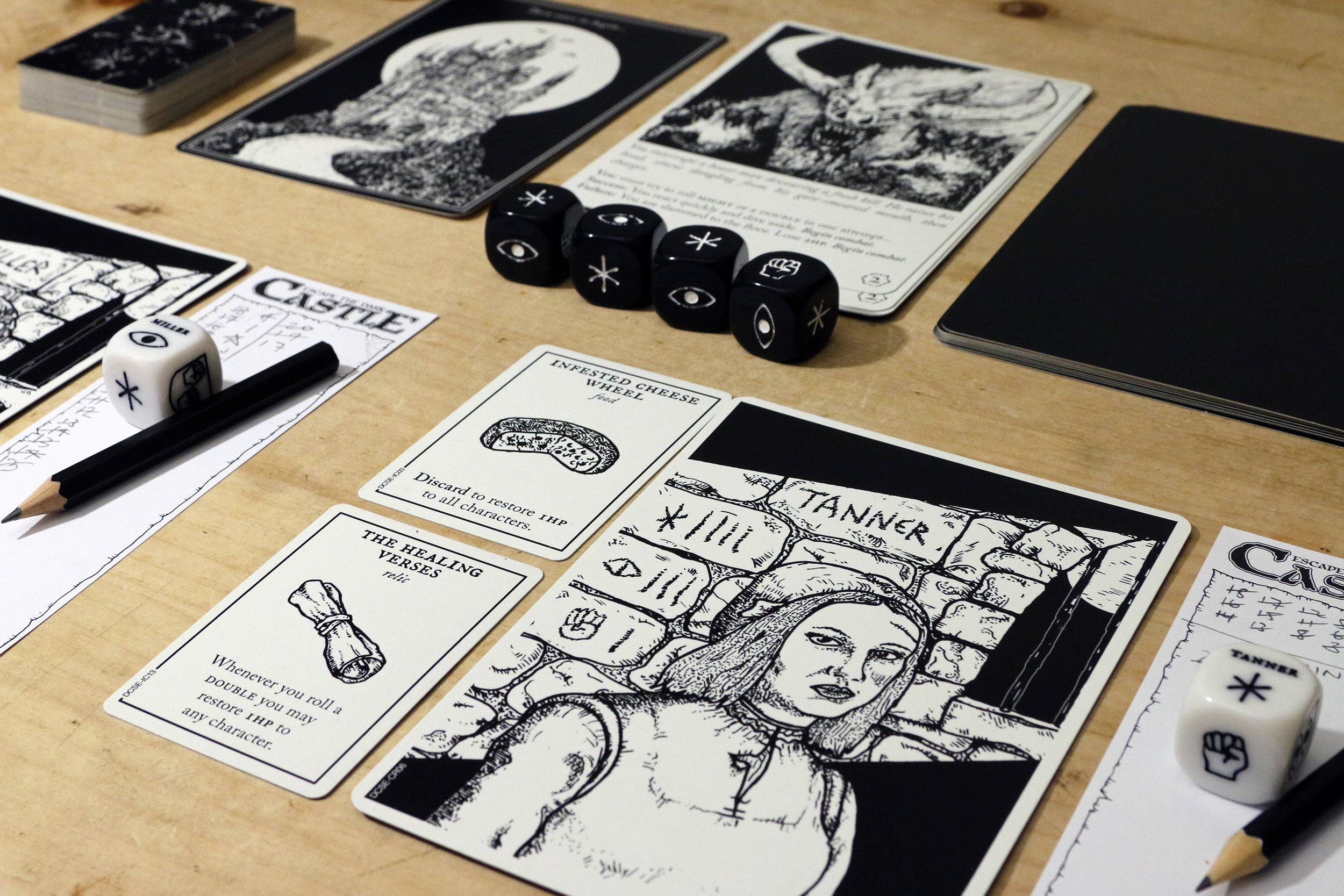
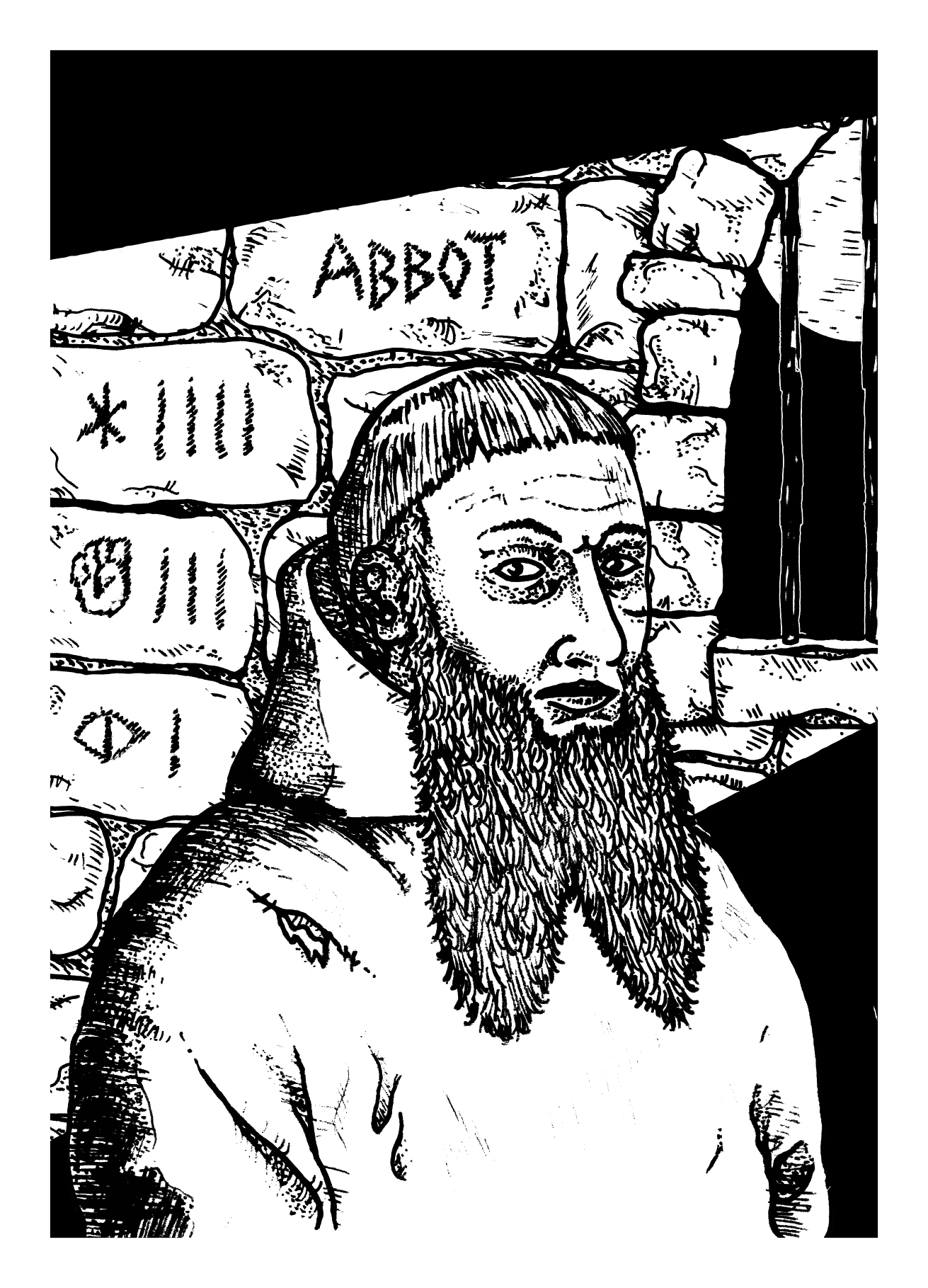
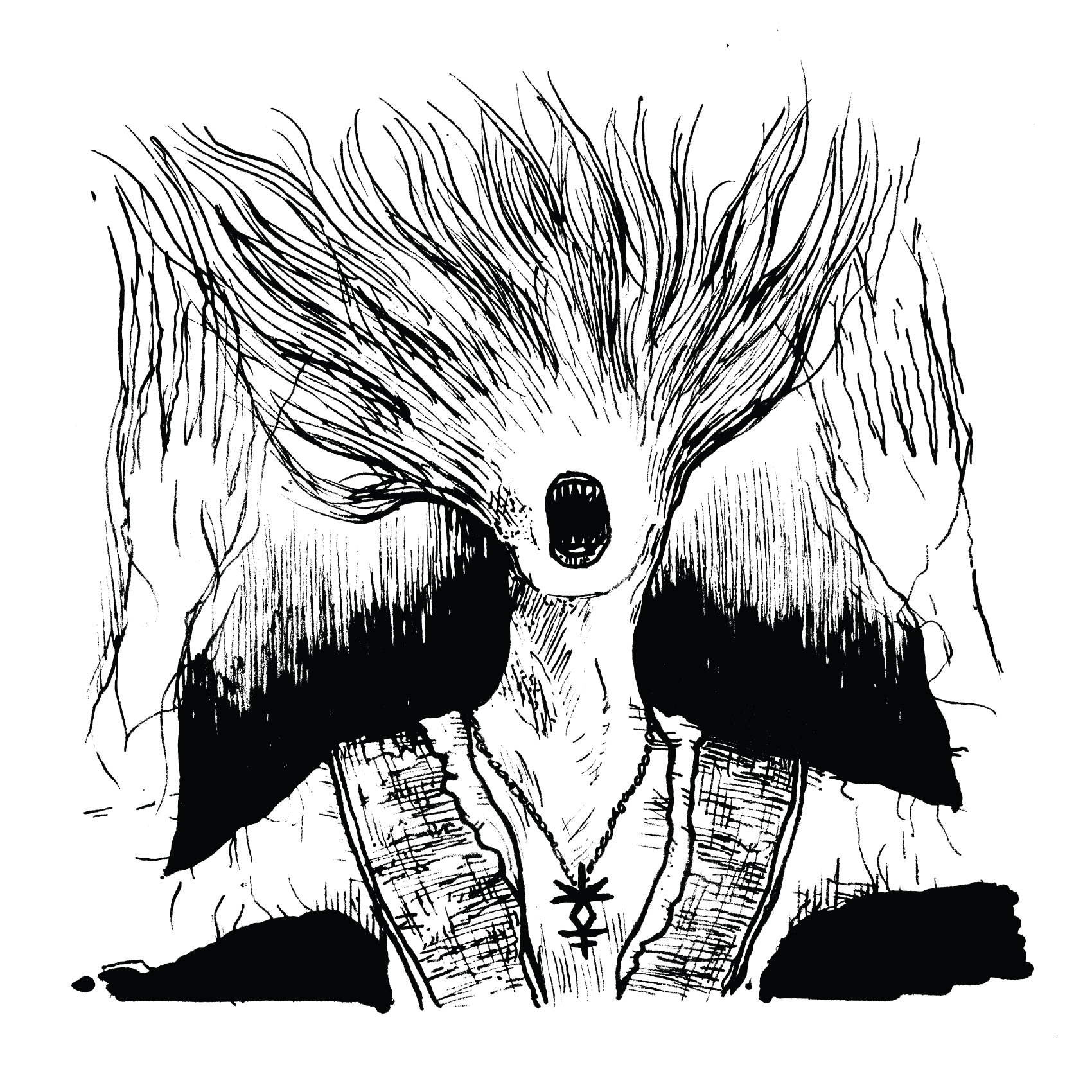
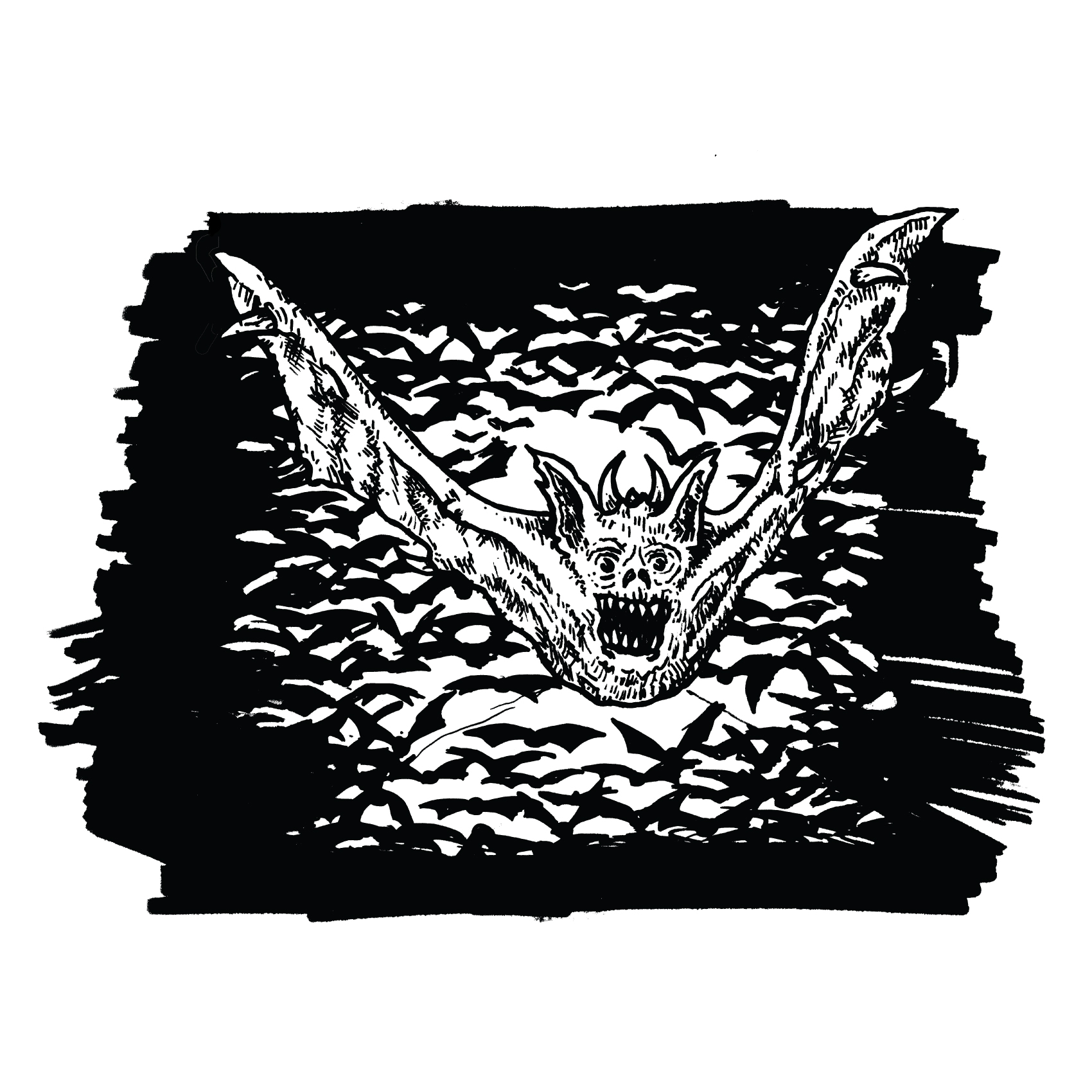
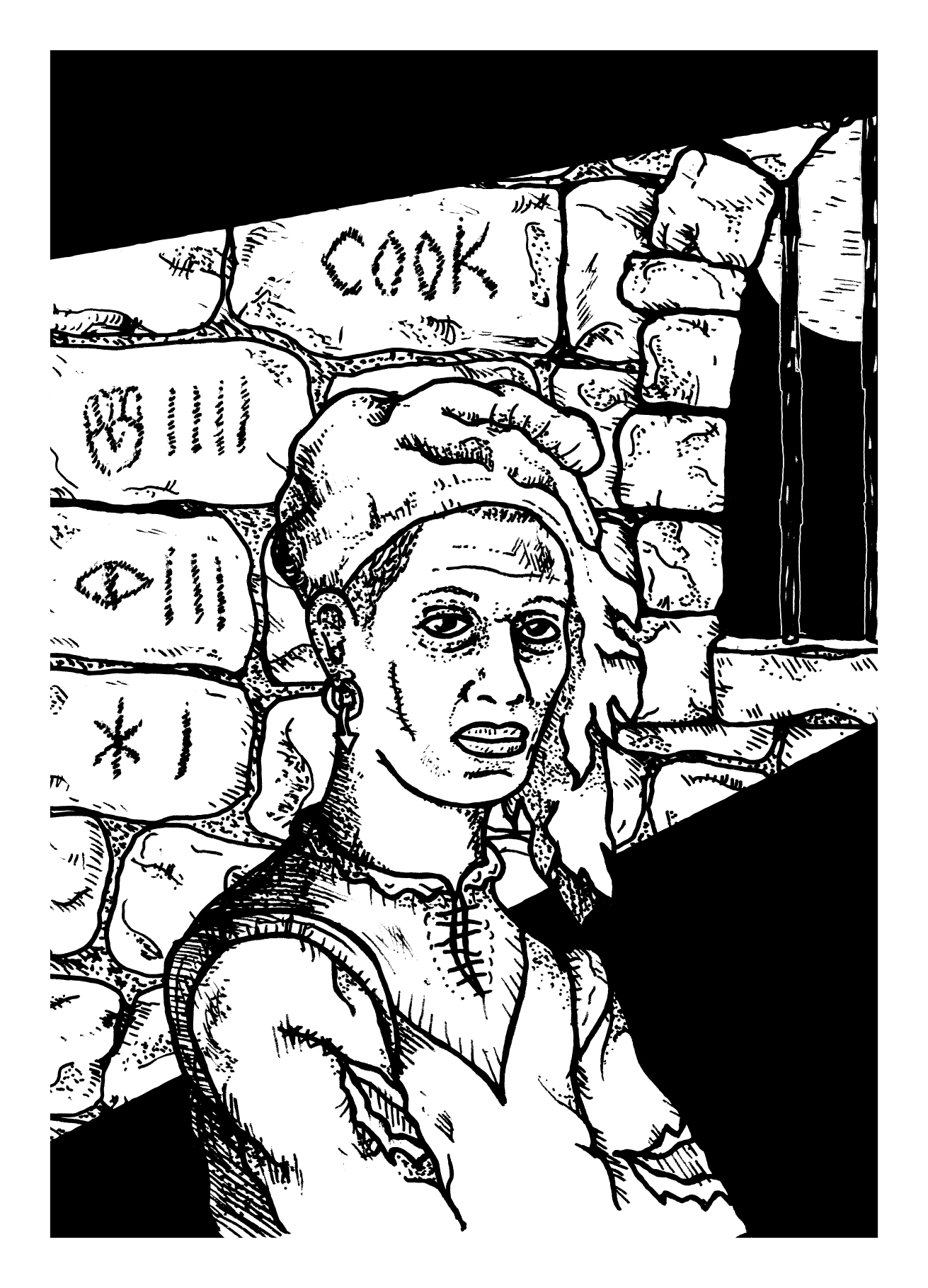
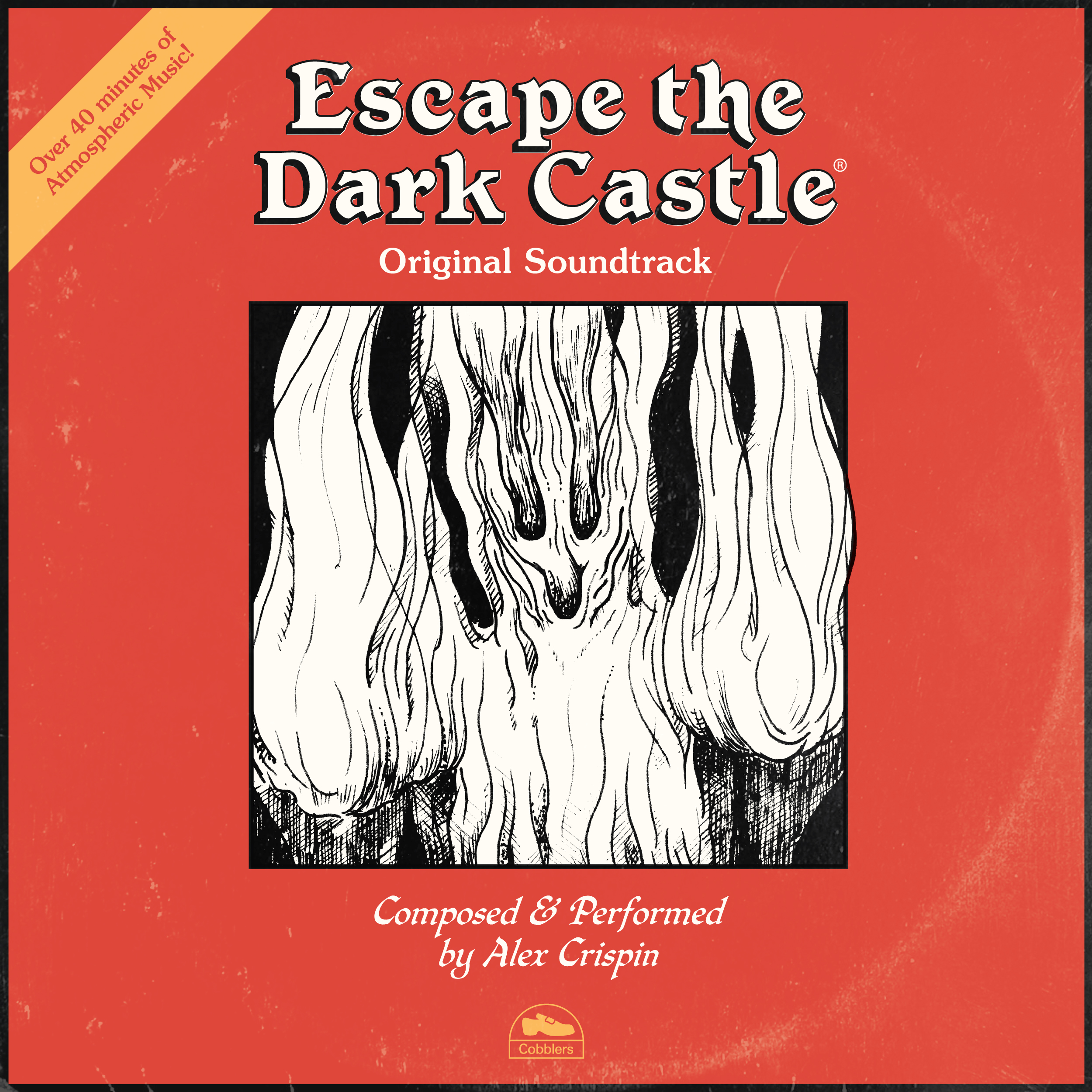
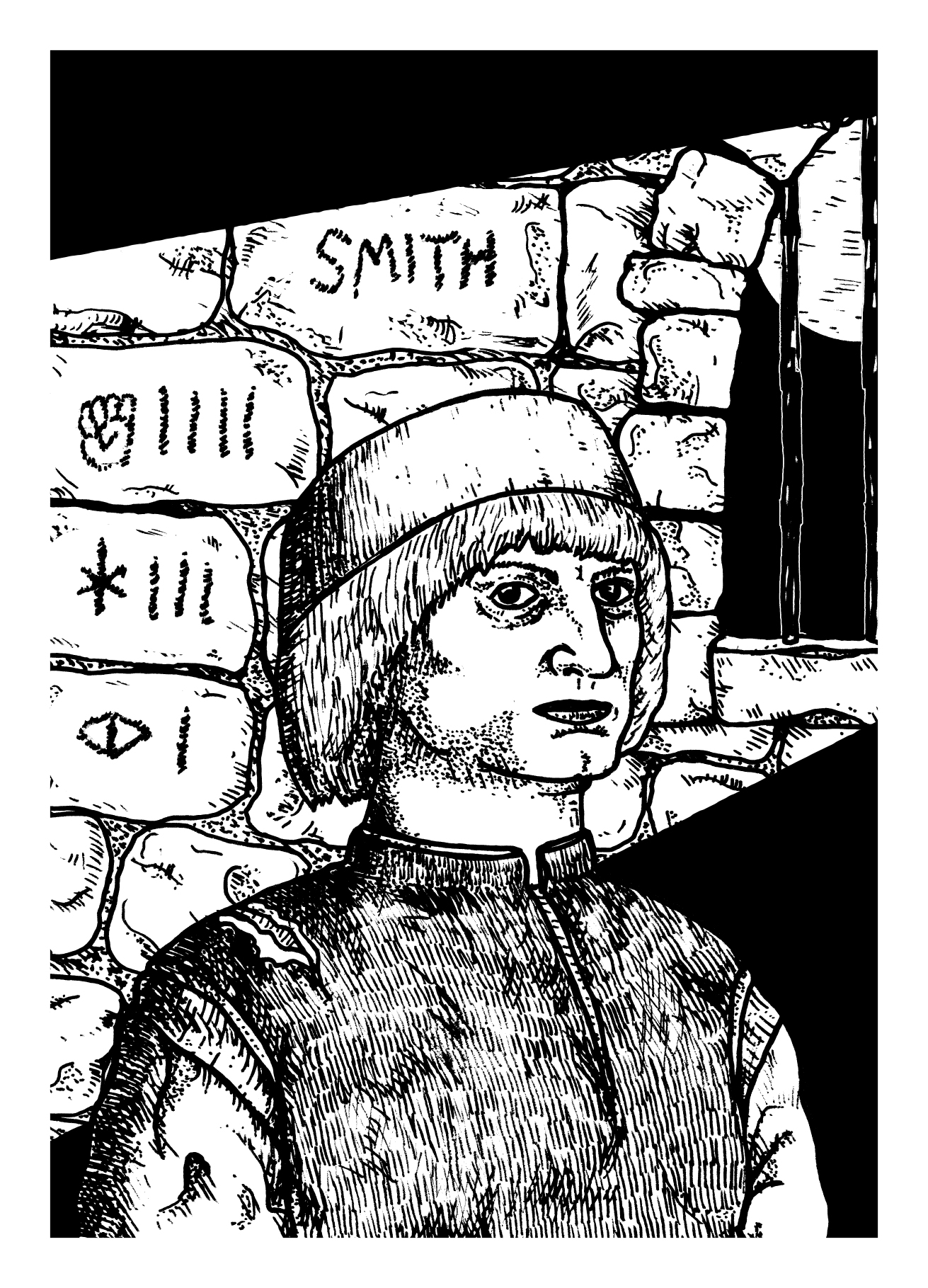
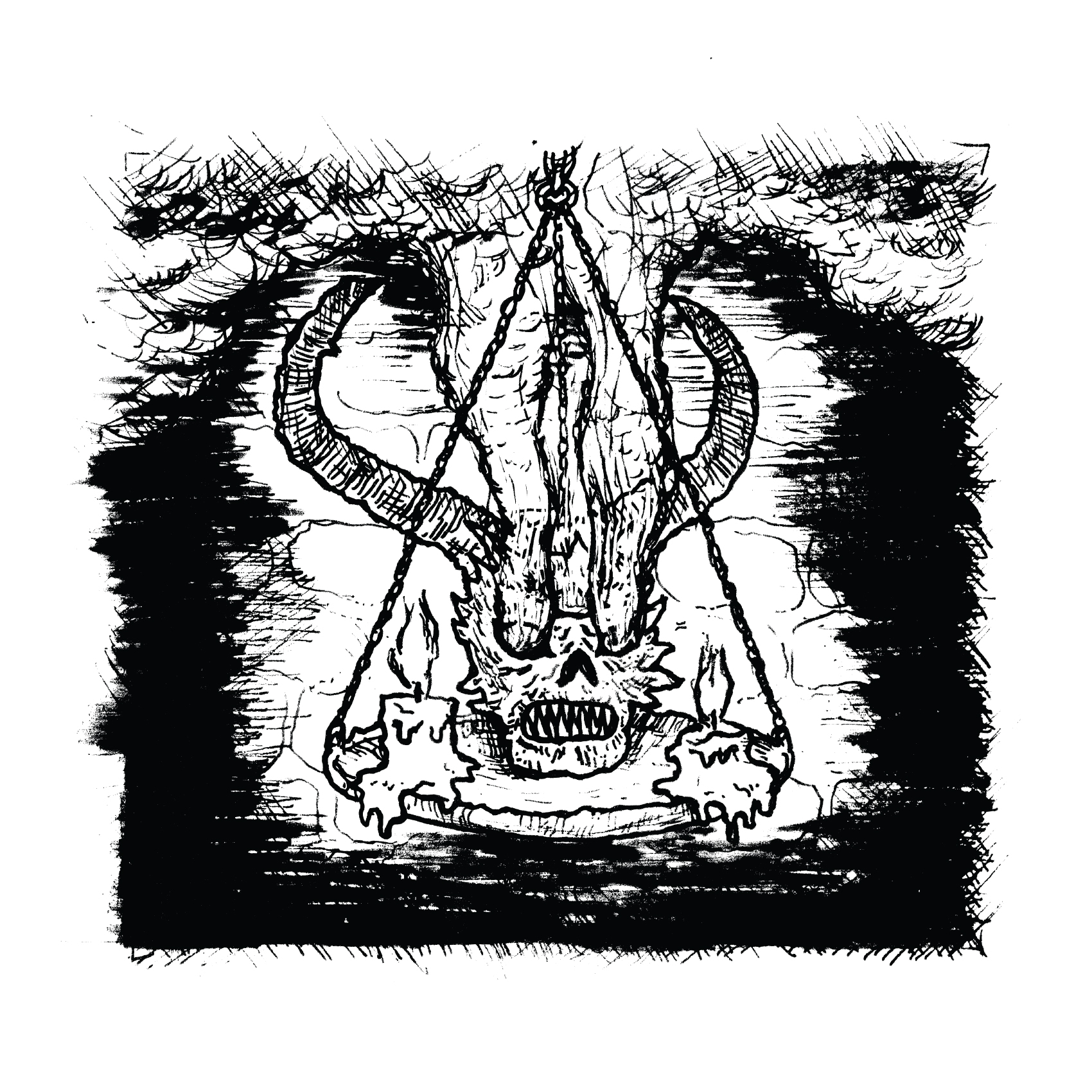
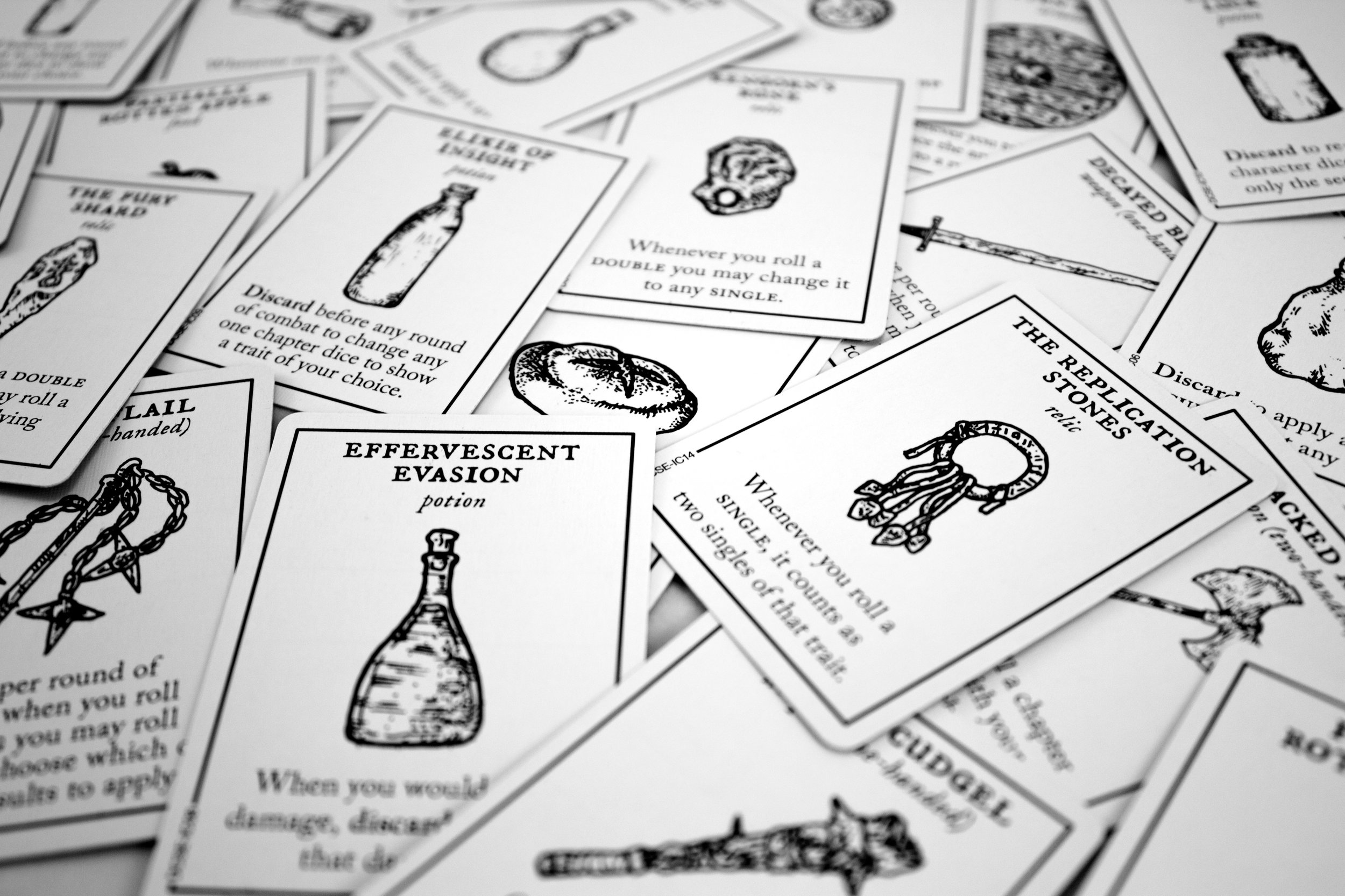
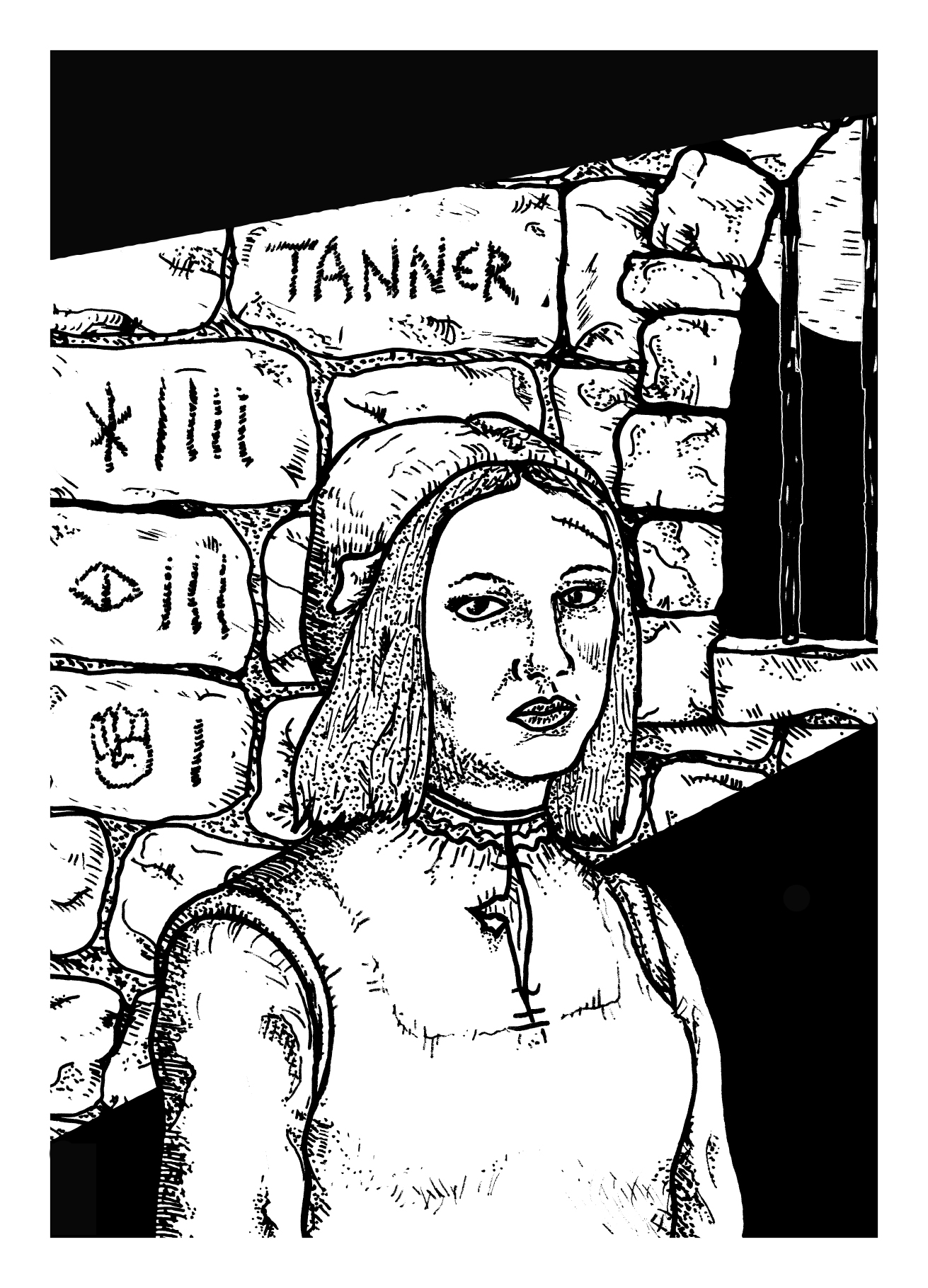
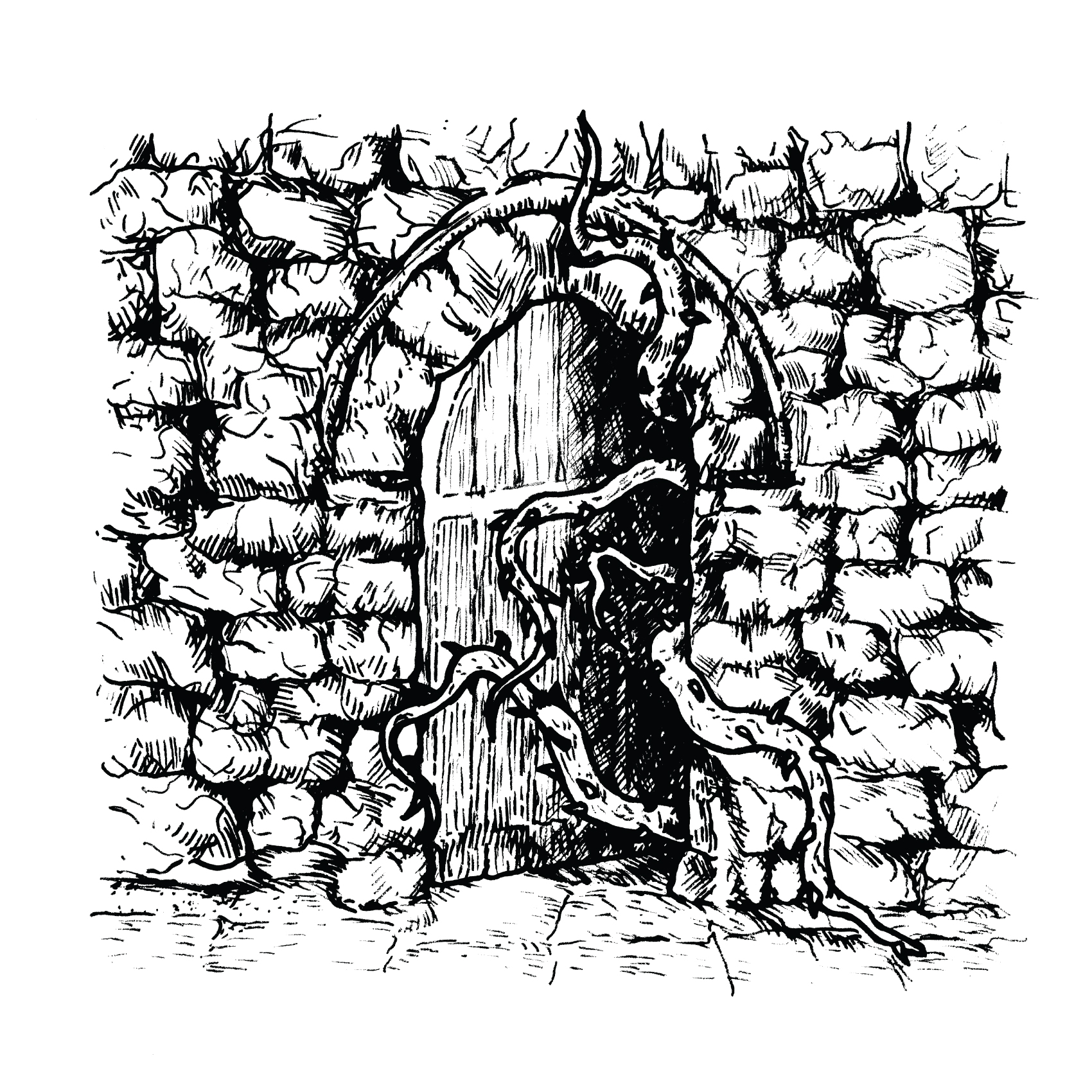
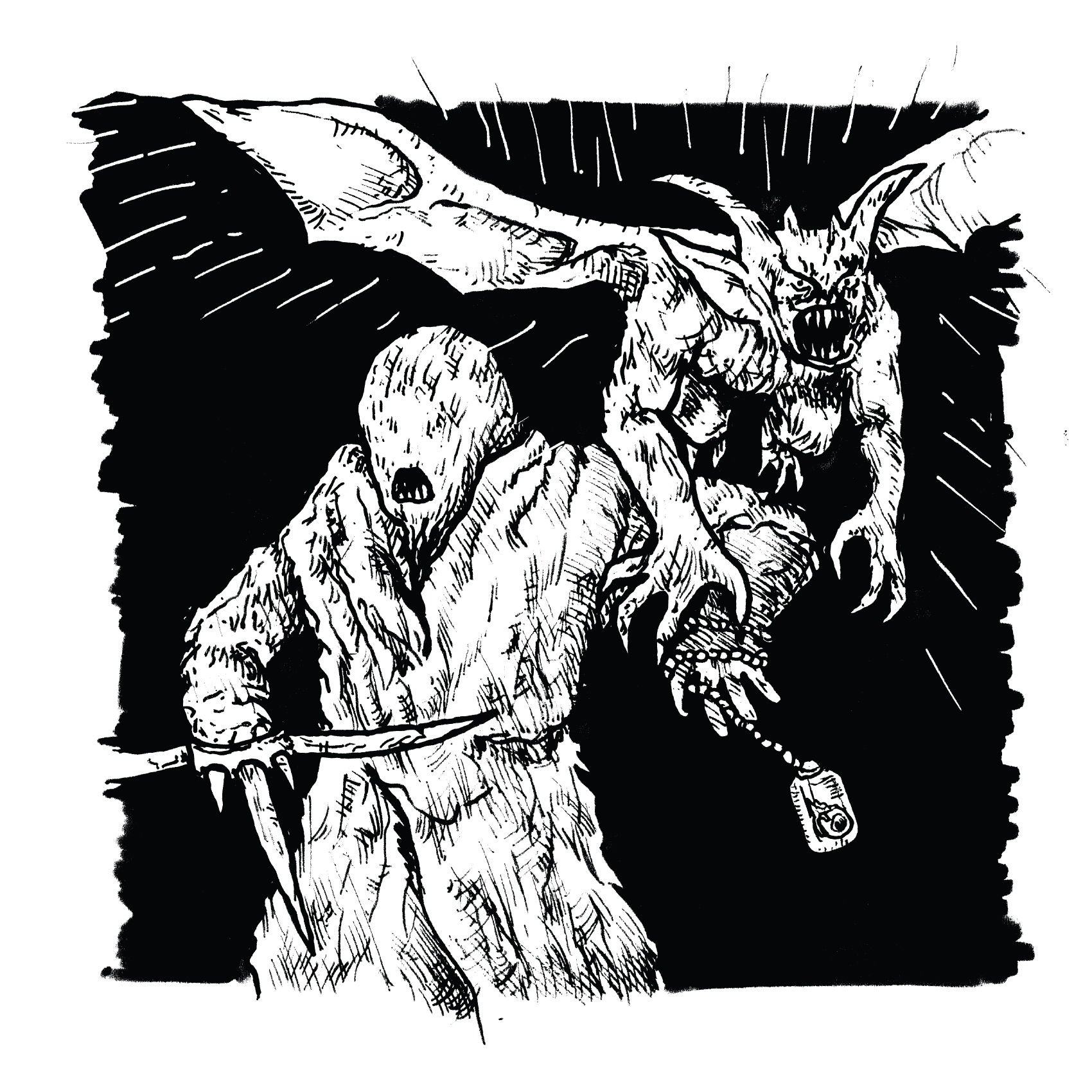
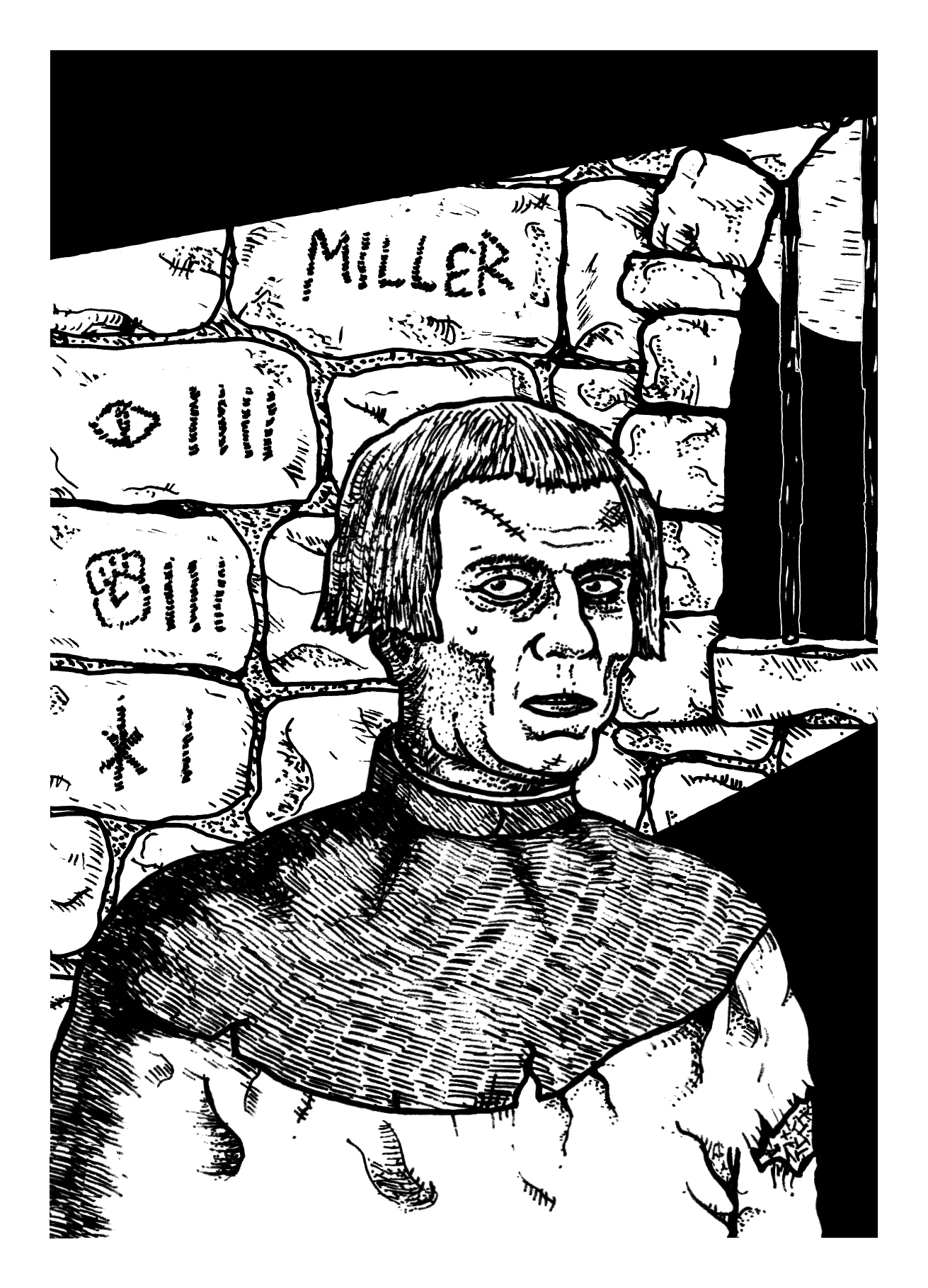
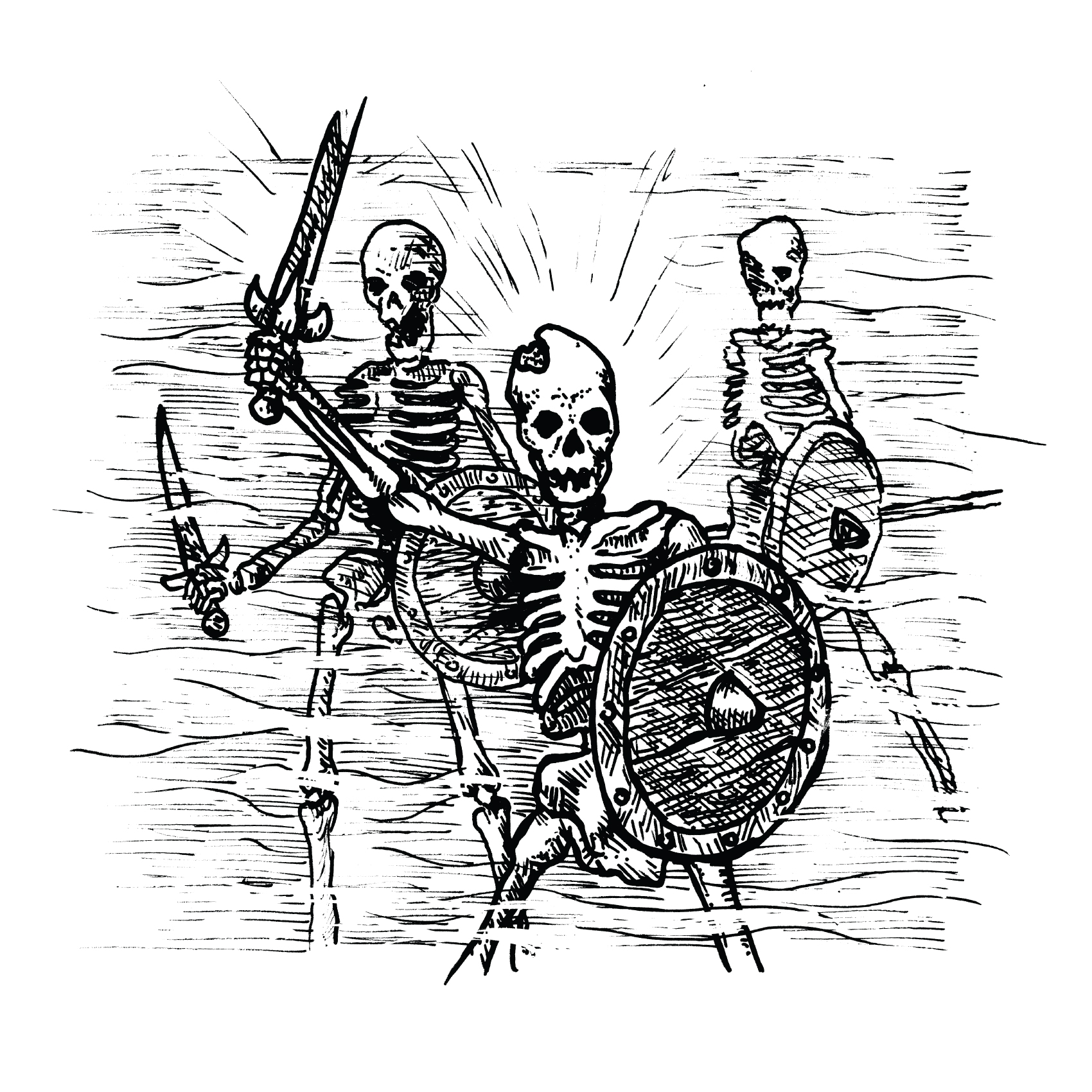
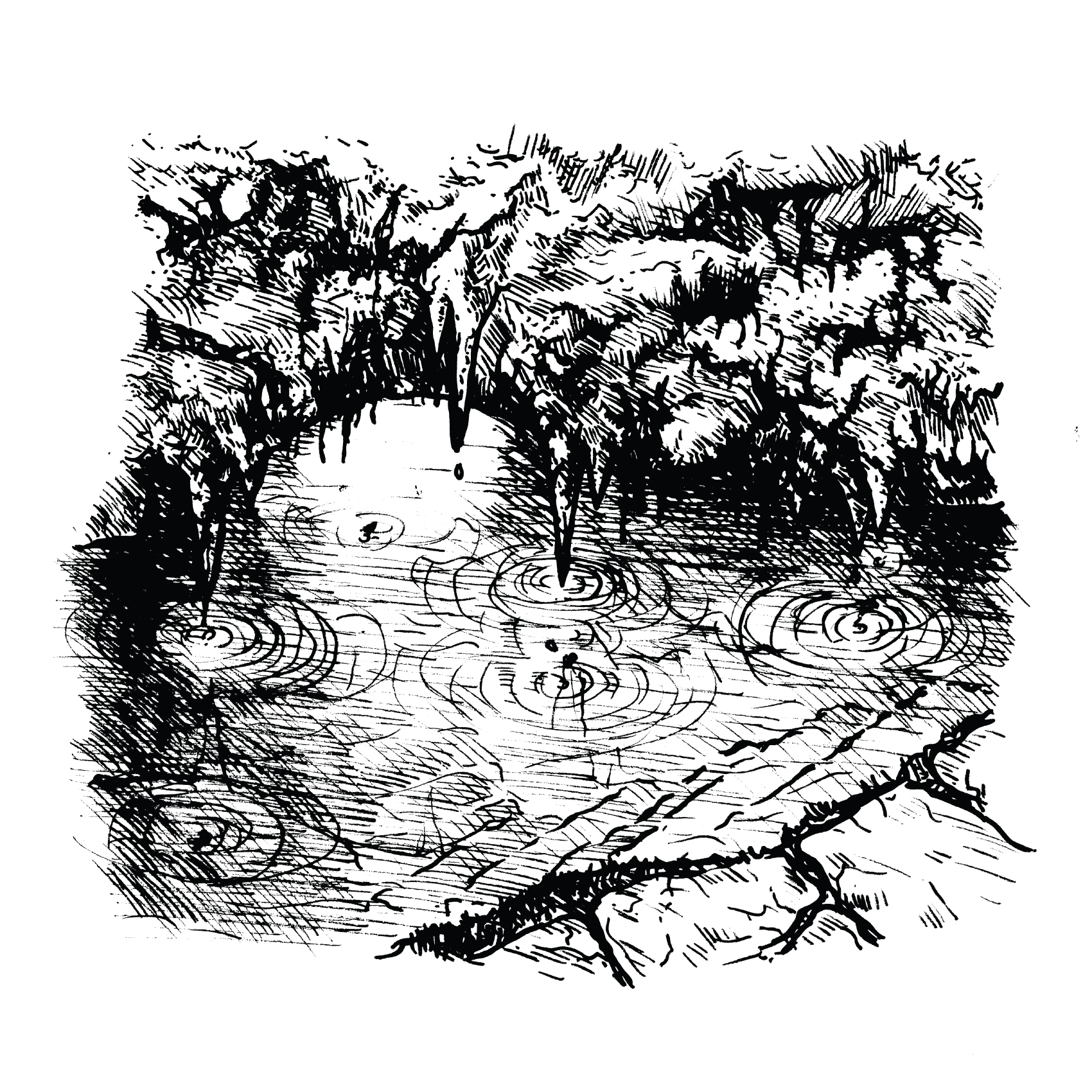
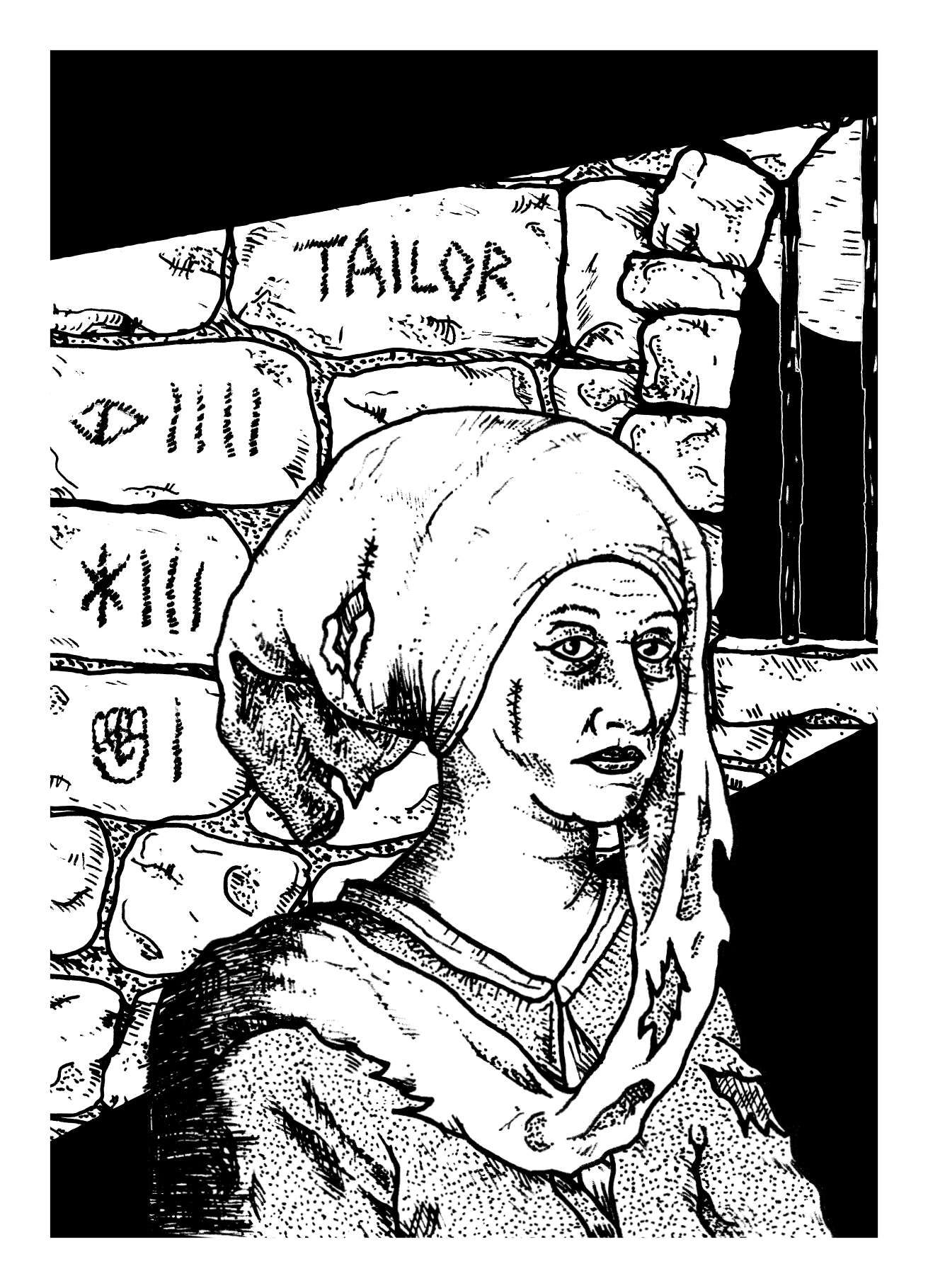
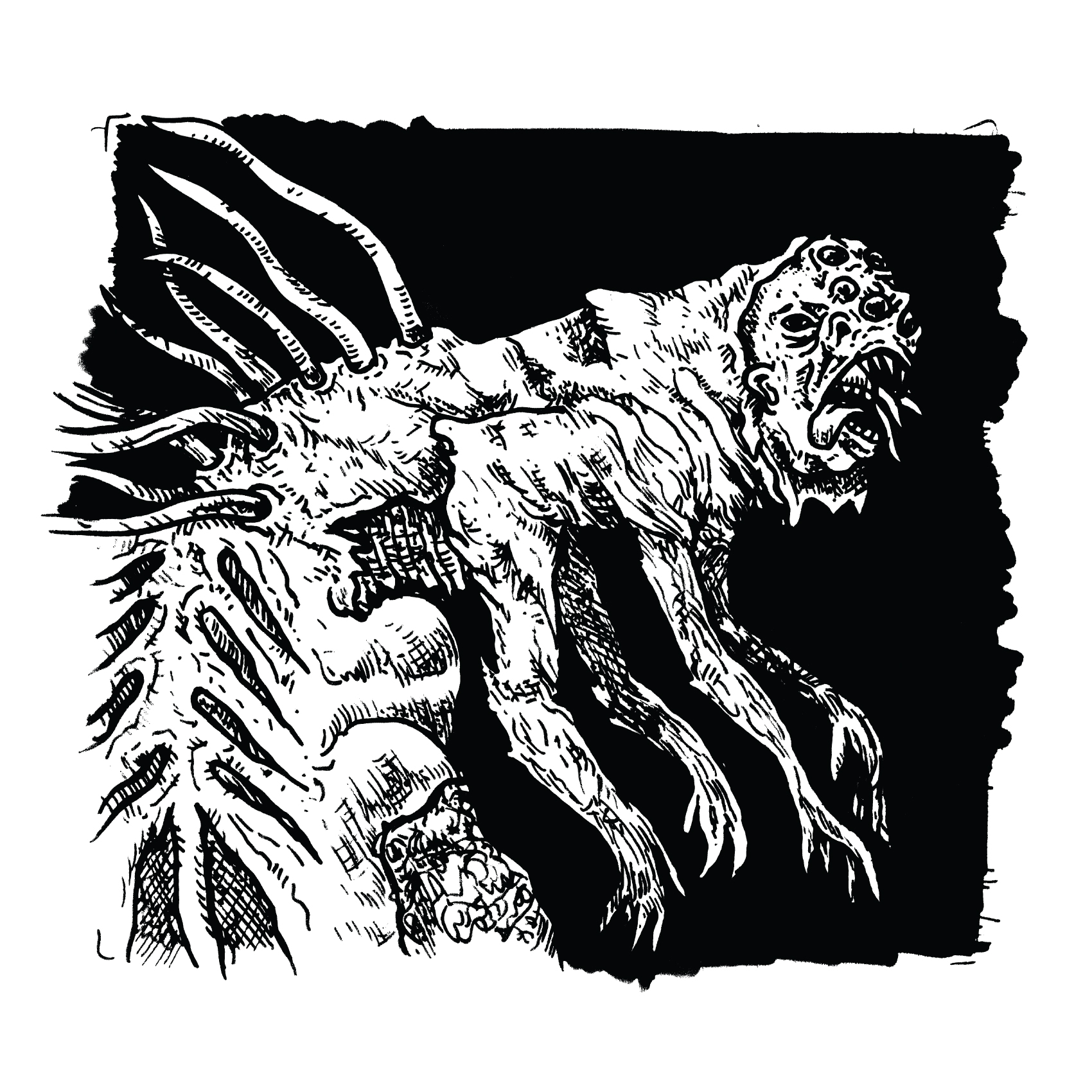
Jesse Riggle: Art in Board Games #27
I'd also recently moved to Europe for a stint and loved seeing all the old castles and wanted to do something with that. So I combined that with my affinity for isometric projections and started to play around and liked where it went. The game features a bunch of unique environments, such as..
This week we have Jesse Riggle an artist and illustrator who worked on the game Unearth with publisher Brotherwise Games.
Hello Jesse, thanks for taking the time to speak to us. Firstly, could you tell us a little bit about yourself?
Sure, aside from commercial work I do a lot of pop culture related paintings for gallery shows and I try to do a fair bit of personal work in my free time. I’ve also spent as much time as possible traveling the past several years.
Now we know a little more about you, I have to ask, as a child what did you want to be when you grew up?
I wanted to be an entomologist (insect scientist) or a cartoonist. I decided in my early teens to pursue the art thing instead of the science thing, but I still sometimes like to imagine a life living in a jungle looking for new bugs.
So how did you first get involved in making board games?
I’ve only worked on one game, and it was something that kind of found me. I did a series of pieces in an isometric style that resonated with the right people and it grew from there. I was super excited to work on the project, as I am a fan of board games and am impressed with the volume of amazing games coming out these days, it seems to be a rapidly evolving art form.
When you are working on the art of a board game can you give us a quick overview of your creative or thought process and has this changed at all since you first started?
My main focus is making art that people will enjoy looking at. It’s kind of secondary to the gameplay, but I think something that is aesthetically interesting adds another layer to the whole experience. I’m also concerned how to keep the art consistent, but unique enough that the different parts are identifiable at a glance.
You were involved in the creation of Unearth, so could you tell us a little bit about what that involved and what were the biggest challenges you faced?
For Unearth I was given the task of creating the overall look and feel of the game. It was based on a style I had already worked in so it came pretty naturally, but I was faced with creating a large number of pieces with unique settings. The biggest challenge was trying to remain consistent whilst keeping the imagery from being too repetitive, which I tackled during the rough sketch phase. I tried to think of larger overall shapes for each piece and then picked different details to focus on as a sort of two-tiered approach. One detail might be a single central structure dominated by a water feature and another a series of smaller structures connected by stairs. I think it helped to try and sketch out as many pieces as possible before moving to the final stages.
What was the inspiration or core idea that drove your work on Unearth?
As I mentioned, the style was based on some personal work I had done just for fun. I often draw strange somewhat lumpy characters and faces, so I had a desire to do something more sculptural and environmental in nature just to mix things up. I'd also recently moved to Europe for a stint and loved seeing all the old castles and wanted to do something with that. So I combined that with my affinity for isometric projections and started to play around and liked where it went. The game features a bunch of unique environments, such as a desert world and an island world, so for those, I drew on my travels around the world to influence the visual language, shapes and color palettes of each environment.
I'm actually doing something similar at the moment in a totally different style to scratch the same itch in mixing up what I do.
What are you currently reading, listening to or looking at to fuel your work?
I’ve been listening to a lot of podcasts recently. My favorites are probably The Adventure Zone, Judge John Hodgman, The Greatest Generation, and Lore. I also have a tendency to have old Star Trek shows playing in the background while I work.
What advice would you give to anyone wanting to work in the board game industry?
Stick to your artistic morals. It seems to be a growing and evolving world with a lot of room for fun and experimentation, so just have fun!
Do you have any current projects underway, or coming up that you’d like (or are able) to tell us about?
I’ve mostly been focusing on some personal projects and gallery work recently, so nothing concrete at this time, but hopefully something fun will come along!
Finally, if we’d like to see more of you and your work, where can we find you?
I’m on Instagram and Twitter under the handle @jessealso and I’m also on tumblr at jesseriggle.tumblr.com.
My main website is jesseriggle.com.
(All images are copyright of Jesse Riggle, 2018).
Andrew Bosley: Art in Board Games #26
Never stop learning and practicing! As my professors used to tell me, it’s the mileage that matters. There are plenty of people with pure, raw, exceptional talent, that have their path laid out for them. But the rest of us just need to work hard. For both art and game design..
This week we have Andrew Bosley an illustrator, concept artist, and game designer who has worked on games such as Everdell, Mission: Red Planet, Citadels, and the upcoming Planecrafters and with companies such as Asmodee, Game Salute, and Ubisoft.
Hello Andrew, thanks for taking the time to speak to us. Firstly, could you tell us a little bit about yourself?
Sure! I grew up in Southern California with a passion for drawing. Had very supportive parents that helped me follow that passion. Took a pretty typical art journey that led to studying illustration at San Jose State University, with my aim to become a visual development artist in feature animation. I interned at Hallmark Cards the summer before my senior year, finished up my BFA in 2006, and then changed directions a little and took a job in video game concept art. I worked in-house at Ubisoft for seven years and then decided to go freelance in 2013. Now I live in cool, northern Arizona with my wife and five kids.
Now we know a little more about you, I have to ask, as a child what did you want to be when you grew up?
I always wanted to be an artist. For a long time, I thought that meant being a Disney animator. Then I decided I wanted to be a children’s book illustrator. I was only exposed to the type of work I ended up in after entering SJSU.
So how did you first get involved in making board games?
I have always loved board games! But it was never something on my radar when it came to work. It was just something I liked to do. After starting my first job as a concept artist in the video game industry, I looked for ways to scratch my illustration itch through freelance work. I got lots of RPG art commissions from the smaller companies. Then some of the bigger publishers took me on. By the time I went full-time freelance, I thought the only options for illustrators in tabletop games was in the RPG market. I went to a fantasy illustration convention looking for opportunities with the biggest publishers and failed miserably. But while there, I met an artist that would soon become a good friend named Bryan Fyffe and he pointed me away from the fantasy illustration rat race towards board games. It was the perfect fit for me and my style. I was fortunate to have established some good connections in the industry and board game jobs starting coming in. Also, when I moved to Arizona, I also started developing my own board game. That led me to GenCon, which led me to lots of new board game clients. While I still do a lot of video game concept art for work, I feel like board games will soon be my long-time home.
When you are working on the art of a board game can you give us a quick overview of your creative or thought process and has this changed at all since you first started?
When it comes to creating the actual illustrations, the process has evolved as I’ve changed as an artist. The process of making the art itself is probably pretty boring to normal people. But I have always had a love of art direction, graphic design, and brand identity and that is probably the thing that I enjoy the most when it comes to creating art for games. Helping to form the overall look of a game/product. When I work of others, I rarely get to look at the big picture in that way. But for my own brands, whether they’re games or apps or stories, I love the process of creating meaningful, iconic themes in style and storytelling.
You were involved in the creation of Mission: Red Planet, so could you tell us a little bit about what that involved and what were the biggest challenges you faced?
Yeah, I had the privilege of doing the cover art and all the character card art for the rebooted Mission: Red Planet. Mission: Red Planet is a great game with some history. Bruno Cathala and Bruno Faidutti created the original back in 2005 with a great artist named Christophe Madura. My job, ten years later, was to create a new look that had some of the influence of the previous version, but could hold up on it’s own and still represent the brand well. Asmodee was a publisher that I had worked with previously and they felt my style would be a good fit for their redesign. Though, I didn’t get to work with either designers during the process, I learned the game and tried to capture the themes and style of the game’s narrative. Then I got to have a lot of fun executing what I thought would make for a cool look!
What was the inspiration or core idea that drove your work on Mission: Red Planet?
It was pretty serendipitous that I was on an Edgar Rice Burroughs binge at the time. I listened to most of the Barsoom audiobooks during the illustrating process. It didn’t necessarily inform the art directly, but it helped me get in the right frame of mind. It wasn’t hard to think about Mars colonization in 1888 with some early 1900’s adventure stories playing in my ears.
What are you currently reading, listening to or looking at to fuel your work?
I really love to listen to audiobooks and podcasts while I work. I recently finished 1776 by David McCullough for the millionth time and I’m now starting the Lord of the Rings series for the millionth time. The podcasts on my regular list are Hardcore History, Trailblazers with Walter Isaacson, the Art of Manliness, and Ludology. Sometimes I throw in some bluegrass music, movie soundtracks, or Enya (that’s right!) when I’m in the mood.
What advice would you give to anyone wanting to work in the board game industry?
If it’s board game art, probably the same advice I’d give to any aspiring artist. Never stop learning and practicing! As my professors used to tell me, it’s the mileage that matters. There are plenty of people with pure, raw, exceptional talent, that have their path laid out for them. But the rest of us just need to work hard. For both art and game design, there are so many fantastic resources out there these days. Both are very generous communities. You just need to grab those resources, study, limit the pointless distractions in your life, and start making!
Do you have any current projects underway, or coming up that you’d like (or are able) to tell us about?
I just finished work on the upcoming game Everdell by Starling Games (Game Salute) which kindly showcased my work handsomely. It’s a great game centered around forest themes and woodland critters. When the publisher first pitched it to me, it reminded me of the Redwall book series I grew up reading and I fell in love. Starling Games was very trusting with the art and allowed me to run with it in fun directions. It’s turned out quite charming! On the personal side, my big project currently underway is a new game coming to Kickstarter this summer. It’s a card drafting, tableau building game set in a fantasy Golden Age of Aviation called Planecrafters. I created it with a good friend and we’ve been working on it for over 2 years now. It’s got a unique game style with a unique art style (that I had lots of fun designing) and it’s something I’m really proud of! Jump to our site www.paisleyboardgames.com for more info!
Finally, if we’d like to see more of you and your work, where can we find you?
My portfolio site is www.bosleyart.com, but you can also find me on Facebook, Twitter, and Instagram.
(All images provided by and copyright of Andrew Bosley).



























